• Get the Best Car for You
• Welcoming our Feathered Friends
• A Culinary Journey in Japan

Your Guide to Making the Most of the Season and Your Membership


• Get the Best Car for You
• Welcoming our Feathered Friends
• A Culinary Journey in Japan

Your Guide to Making the Most of the Season and Your Membership

Long, dark nights in wild landscapes with no light pollution. Arid climates and minimal cloud cover that provide crystal-clear views of the cosmos. A prime location under the auroral oval—the thin band around the Earth where the most intense Northern Lights activity occurs. Experienced guides who know precisely where to go for intimate, life-changing Aurora experiences. Put all that together and it’s clear why the Northwest Territories is the best place in the world to see the Northern Lights.
With direct flights from Ottawa, Toronto, Edmonton, Calgary and Vancouver, getting to the light show has never been easier.






Prairie Wildlife Rehabilitation Centre cares for Manitoba’s injured wildlife, one quill (and feather) at a time Executive
PRESIDENT’S MESSAGE
MEMBER LETTERS ON THE RADAR
Travel, arts, culture, local hot spots and more TRAVEL
Flight cancelled at the last minute? Here’s how to salvage your trip
AUTOMOTIVE
Essential maintenance basics that new vehicle owners need to know

THE GOOD PLACE
BIRD CALL
Grab your binoculars—here’s how to welcome and nurture our local feathered friends
GET THE BEST CAR FOR YOU
Finding the right vehicle starts with being honest about your needs and how much you can afford
Refreshing savings, safety tips and how to prep your space for April showers and May flowers. Plus, CAA Member updates, helpful resources and what’s coming next
FAMILIAR GROUND
Is this spot a hidden gem, a classic landmark or right in your own backyard? Take a guess!
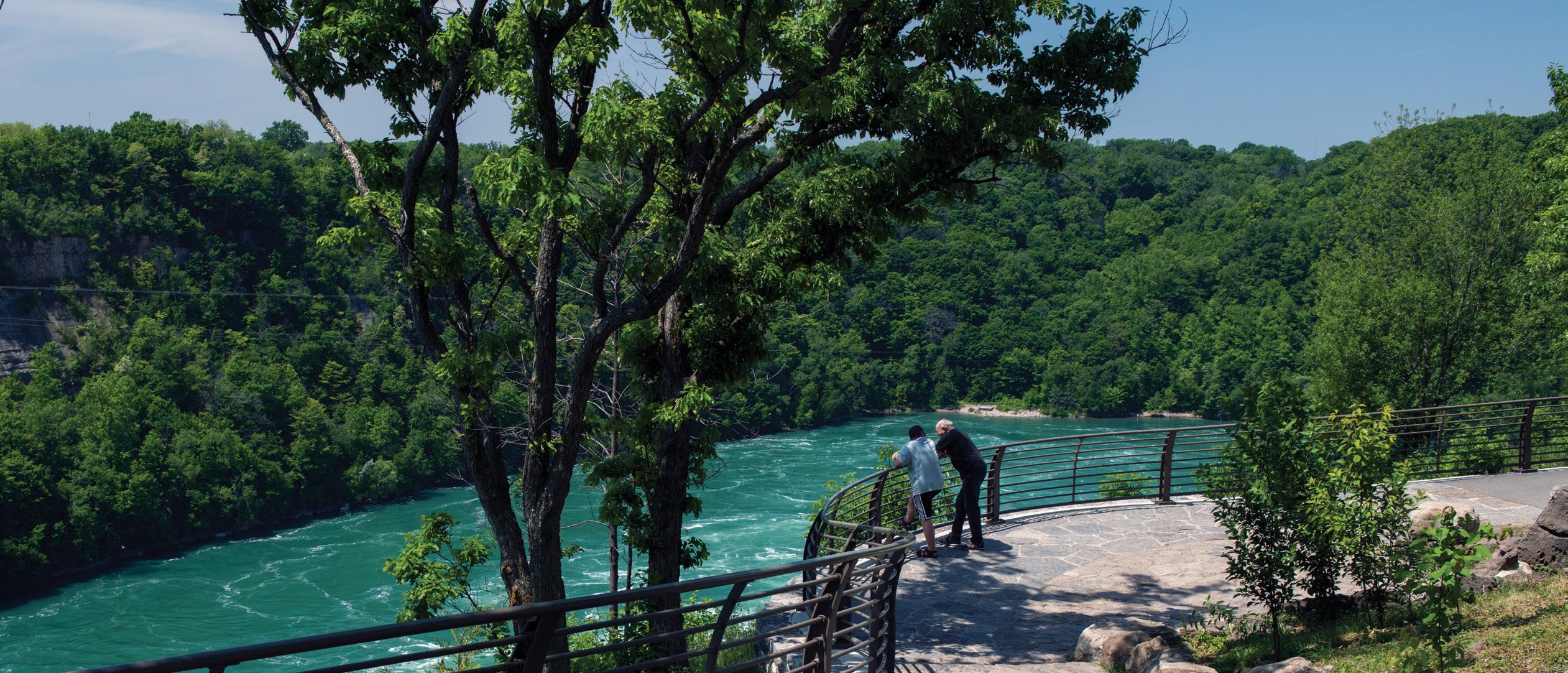
SPONSORED
Sunny skies and open spaces mean spring is the perfect time to explore New York State’s scenic state parks and world-renowned cultural sites. Read on for some new stops to add to your next road trip.
On April 8, 2024, the moon will pass between the Earth and the sun, creating a total solar eclipse. Much of New York State—including Buffalo, Rochester, Syracuse, Lake Placid and more—will be in the path of totality, meaning they will see the sun fully eclipsed by the moon and experience total darkness for almost four minutes. To accommodate the projected influx of visitors, several state parks are offering campsite reservations for those who wish to stay overnight for the celestial event.
A new 28,000-square-foot visitor centre at Niagara Falls State Park has recently been completed in time for the park’s 2024 centennial. What’s more, the Niagara Gorge Discovery Center is reopening just in time for spring.
Featuring sweeping views of the falls, interactive exhibits and scenic hiking trails, these
locations make for a perfect introduction to everything New York has to offer.
For those hungry for culture, New York State’s cultural institutions have never been more impressive. The Buffalo AKG Art Museum, which houses works by major artists, such as Edgar Degas, Andy Warhol and Cindy Sherman, has reopened following a $200-million renovation. The Strong National Museum of Play in Rochester— which houses family friendly exhibits and the world’s largest collection of historical materials related to play—has been recently expanded as well. Further afield in the Hudson Valley, the Storm King Art Center, which boasts the largest collection of contemporary outdoor sculptures in the country, has been undergoing a major sustainability-focused renovation for 2024.
This, of course, is just a small selection of the many things that makes New York State the perfect road-trip destination. From nature to culture, there’s a whole world of wonder waiting to be discovered just over the border.
From nature to culture, there’s a whole world of wonder waiting to be discovered just over the border
 Niagara Gorge Discovery Center acts as a trailhead for scenic hikes that highlight the area’s picture-perfect landscape.
Niagara Gorge Discovery Center acts as a trailhead for scenic hikes that highlight the area’s picture-perfect landscape.
A VERY WARM GREETING to all of our Members in Ontario and Manitoba. This is the first edition of CAA Magazine with our opening column addressing our valued Members from both provinces, following the well-earned retirement of CAA Manitoba’s general manager, Tim Scott. We thank Tim for his years of service and wish him well in his retirement.
As we look forward to welcoming the spring and all of its splendid sights and sounds, I hope the articles and special features that our writers and editors have curated in this edition of CAA Magazine will inspire you to explore the season’s many beautiful attractions.
The high cost of living coupled with an uncertain economy, however, weighs heavily on everyone’s minds. As with most companies, CAA’s operating costs have risen as well, but we made the deliberate decision not to pass them to our Members. We are instead absorbing these costs while also finding new ways to add more benefits to help ease some of the burdens our Members face in everyday life. I have written about these new benefits in past editions of CAA Magazine and hope they will be of service to you and your loved ones.
I recently had the pleasure of speaking with several Members who use Maple’s virtual health-care benefits that are included in every CAA Membership. With the ongoing health-care shortage in Canada, these Members were able to consult a physician quickly from their own home. While Maple health care is not intended to replace a family doctor, this CAA benefit does provide a lifeline for those situations when you need to consult a physician right away.
On behalf of every caring Associate at CAA, we thank you for placing your trust in us and wish you and your family safety and good health.
With every good blessing,
Jay Woo Jay Woo President and CEO CAA Club Group of Companies
Jay Woo President and CEO CAA Club Group of Companies
In accordance with its bylaws, the CAA Club Group Annual Meeting will be held virtually via Zoom video conferencing on May 16, 2024, at 3 p.m. (CT), to address the following agenda items:
• Receive the consolidated financial statements for the fiscal year ending Dec. 31, 2023.
• Elect directors.
• Appoint auditors for 2024.
• Receive the Annual Report.
• Conduct such other transactions as may properly be brought before the meeting.
To learn more, visit caamanitoba.com/agm. Pre-registration will be required.

 SCAN ME
SCAN ME
Thank you for “Creature Comfort,” by Vawn Himmelsbach, in the winter 2023 issue. Travellers don’t always consider the treatment of the animals they encounter while on vacation, but would be horrified if they knew what many animals endure for tourists’ entertainment. I appreciate CAA helping to educate readers on this very important and often overlooked topic.
—Nicola M.The article exposing the cruel and horrendous treatment of wild animals for the amusement of tourists was brave, well written and seriously needed. Exposing how animals are abused for money is an important cause, and the references for research were fantastic. It’s great to see how CAA is creating awareness to help encourage tourists to respect the planet and the animals on it.
—Valerie W.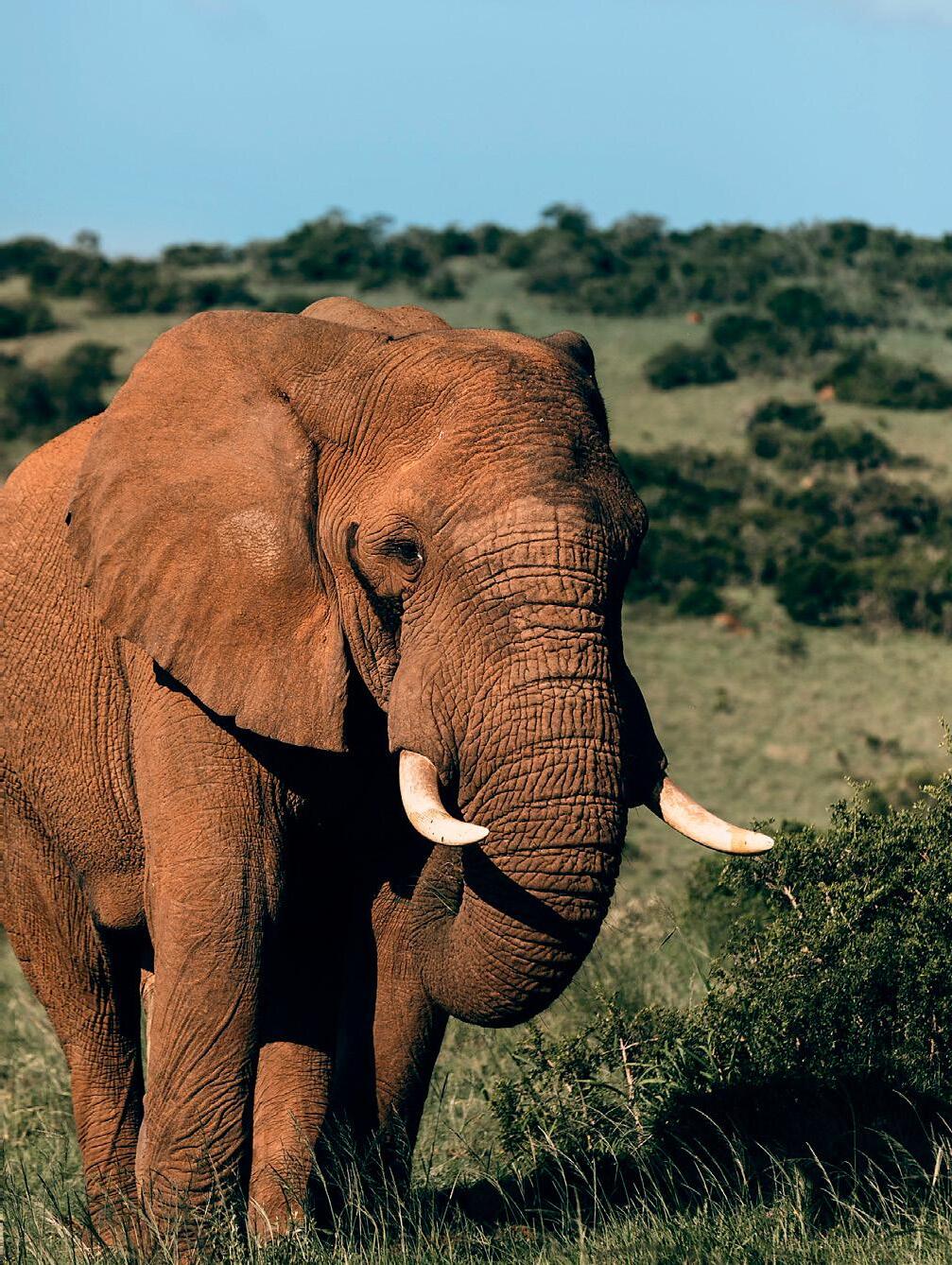
I bought the extended warranty when I leased my 2018 Toyota RAV4. When I took it in to pick up my new one in 2022, there was a crack in the windshield, which the extended warranty specifically stated it covered. However, my local Toyota dealer made me pay $1,400 for a new windshield, citing that the extended warranty was invalid, as it was the Toyota dealer buying my vehicle, not Toyota. I was so angry and will never buy an extended warranty again.
—Jean G.I succumbed and purchased an extended warranty on my 2018 Genesis G80. In 2023, I noticed that the tuner and volume knobs on the radio controls didn’t work, although the duplicate controls on the steering wheel did. The bad news was that it cost $6,000 to repair. The good news was that it was covered by the extended warranty
—Peter S.
In response to “Over Extended,” by Matt Bubbers, in the Winter 2023 issue.
It’s great to see how CAA is creating awareness to help encourage tourists to respect the planet and the animals on it
Have a story or comment you’d like to share? Email us at magazine@caamanitoba.com and you could be featured in an upcoming issue. Letters may be edited for length and clarity.

I was pleasantly surprised when I received the cozy blanket from CAA last week in recognition of my 50 years of membership. I have relied on my CAA Membership for helping me out of minor inconveniences, such as locking my keys inside my car, to major mishaps, such as being towed out of a few ditches that I’d slipped into on our icy roads. CAA is a service I count on, especially in winter.
—Suzanne W.



Visit colour.Dulux.ca to order large, 8”× 8” swatches of Limitless or any of your favourite paint colours.


Vision by Dulux BIG paint colour swatches help you envision your next paint project, right at home.
PLUS get 25% off any Dulux manufactured product & earn 3% in CAA Dollars® when you swipe your CAA card at your local Dulux Paints store. Visit Dulux.ca/CAA for details.

Discover first-hand why the Laurentian Mountains are a renowned international destination
THEY’RE BEST KNOWN FOR skiing, but there are many ways to enjoy an outdoor adventure in the Laurentians after the winter snow has melted.
This is the first national park created in Quebec, in 1895—a trove of trails, lakes (over 400 in the park), rivers and creeks. La Corniche is a medium-difficulty hike with some elevation change to get your heart pumping as you reach the lookout point with stunning views over Lac Monroe. The park also offers a Ready-toCamp program, starting between late April and mid-May, featuring pre-assembled tents equipped with space heaters for cooler nights.
This refined camping experience, just minutes away from Mont-Tremblant National Park, combines the best of scenic aesthetics (A-frame cabins) with home-like comforts (king beds) in nature. If you’re not staying overnight, stop by
Once you reach the
top, you can challenge your fear of heights by walking out on a net suspended in the centre of the panoramic lookout tower
the café (open weekends in spring) for a coffee, a local beer or a glass of wine. You can rent paddleboards and electric fatbikes to explore the land around the property. Farouche also sells herbs and spices grown on their farm, which make excellent gifts. And if you ask, they might even let you explore the farm yourself.
Built in 2022, the Sentier des Cimes is a spiralling boardwalk and observation tower tucked into the pine, spruce and maple forest of the Laurentians. The 1.5-kilometre journey from the front entrance to the top of the 40-metre-high tower is fully accessible for those with strollers and mobility aids. Once you reach the top, you can challenge your fear of heights by walking out on a net suspended in the centre of the panoramic lookout tower.
One of the first Nordic-style spas to open in Canada, in 1999, the Scandinave Spa Mont-Tremblant has hot and cold pools, dry heat saunas and steam baths—classic après-ski activities that are just as luxurious in the spring. It’s perched along the Rivière du Diable, so you’re welcome to challenge yourself with the ultimate cold plunge in the river itself. Or simply zone out in one of several relaxation rooms or outdoor loungers set up around firepits and wood stoves.
MANY PEOPLE DREAM UP new business ideas while working on their MBAs. For Kathy Tran-Riese, that business school project idea turned out to be a game changer.
KayTran Eyewear was born from Tran-Riese’s desire to create more eyewear options designed to fit individuals who—like Tran-Riese herself—have lower nose bridges. “You’d go into a store and there would be hundreds of eyewear options on the wall, and each one you tried on would just slip down your nose or sit on your cheeks,” Tran-Riese recalls. “I wanted to start this brand to offer stylish options that didn’t always have to have rubber nose pads.”
The company released its first collection of sunglasses in 2012, and today, more than a decade after its launch, the Winnipegbased brand is thriving. Celebs like Lucy Liu and Jessica Henwick have discovered the brand, and shoppers from countries as far away as Germany, Singapore and the Philippines have discovered KayTran’s eyewear, too. The brand recently launched its first full optical collection plus a men’s collection, and some styles are now available at select independent boutiques.
For Tran-Riese, the enthusiastic response from customers has been very affirming. “I have a lot of positive feedback from customers who emailed me after they purchased their first pair and just felt that sense of relief—or disbelief, almost,” she says, “because they had gone their whole lives, similar to myself, wearing frames that just did not fit them properly.”
–Truc NguyenNominate a Localer. Do you know someone who goes above and beyond to make the world a better place? We’d love to hear about them. Send nominations to drivenbygoodmb@caamanitoba.com and they could be our featured Localer in an upcoming issue.


Made with Tilley’s signature Airflo mesh for ventilation and an exterior fabric that repels water and blocks the sun with a UPF 50+ rating, this lightweight slim-brimmed hat shields you from rain or shine.

• stays afloat in water
• secret interior pocket for stashing valuables
• four colour options
Get outside.
Visit shop.caamanitoba.com to cop this cap with Memberexclusive pricing.
Ditch that pitched tent for one of these glam campsites across Canada
AS THE WEATHER WARMS UP, it’s time to sleep under the stars—in style. From a horse farm with see-through domes to ultra-cozy, oceanside tree pods, take your pick from these wonderful glamping spots from coast to coast.
CAMP WOLF WILLOW: Outlook, Sask.
This magnificent 100-acre property sits on the hills above the South Saskatchewan River, 80 kilometres south of Saskatoon. Alongside traditional campsites are solar-powered glamping options, including wooden A-frame cabins and luxury canvas tents. And there’s entertainment for both young and old. Think kiddo-geared seasonal activities, like a lilac maze and pumpkin patch, and the adult-friendly winery and pizzeria right next door.
Coldstream, B.C.
Located 65 kilometres northeast of scenic Kelowna, this Indigenous-owned “glampground” delivers on its name. Not only is it located in a former plant nursery—with 20 acres to explore—it also has farm animals on-site, including a Jersey calf, giant rabbits and dwarf goats. The tents are dressed to the nines with queen beds and handcrafted furnishings.
ELK ISLAND RETREAT: Fort Saskatchewan, Alta.
In the heart of the Alberta wilderness, just east of Edmonton, is Elk Island Retreat, a 60-acre family-owned campground with four geodesic domes, two yurts and three cabins— thoughtfully kitted out with gas fireplaces, outdoor barbecues and cozy queen beds. Jurassic Forest is a 45-minute drive away, and luxury catered picnics are available on-site.


GLEN ORO FARM: Hawkestone, Ont.
Calling all galaxy gazers… Glen Oro Farm, situated some 130 kilometres north of Toronto, features nine geodesic domes with see-through walls and ceilings, perfect for marvelling at the starry night sky. There’s also a 200-acre horse farm (guests can gallop through the nearby forest if they wish) plus five luxurious canvas tents, a spa-style cold plunge and a cedar-barrel sauna heated by a Finnish wood stove.
TREETOP HAVEN: Mount Tryon, P.E.I.
The ultra-cozy accommodations at Treetop Haven, an all-season family-owned property, are nestled amid green space 45 minutes west of Charlottetown. Glampers can choose from five TreePODs—a cross between a treehouse and a pod or dome—as well as a vacation apartment and a lodge (both accommodate up to nine guests each). Everything the east coast has to offer is just a hop, skip and jump away—lobster shacks, red sand beaches and the Atlantic Ocean.
An exploration of the impact of climate change on Northern communities, Dark Ice is a collaboration between Leslie Reid, an Ottawa-based painter and photographer who has spent time in the Arctic, and Robert Kautuk, a drone photographer in Clyde River, Nunavut. Through photos, paintings and videos, the two artists create a hauntingly beautiful dialogue that hints at hope for a path forward. A must-see at the Winnipeg Art Gallery-Qaumajuq (wag.ca) until May 26. –Beth Hitchcock

Winnipeg country-folk artist Don Amero is a threetime Juno Award nominee and a CCMA nominee for best album for 2021’s Nothing Is Meaningless. He is promoting his latest EP—Six—along with his children’s book, These Roots of Love. When this Indigenous singer gets behind the wheel, he “likes driving with music I can sing along to. It’s got to have a mix of good vibes, good beats and heart.”
–Karen BlissConvertible
Kelly Prescott
Chris Stapleton
Stand and Deliver
Patrick Droney
Wheels Off
Don Amero
The Good Ones
Gabby Barrett
Seeds
Julian Taylor
Opaline
Nova Amor
Workin’ on Whiskey
Jessica Mitchell
Somebody Else
Aysanabee
Lose Control
Teddy Swims
Songs may not be appropriate for everyone.
Listener discretion is advised.

CANADA IS A GOLF-RICH COUNTRY with renowned resorts where you can “grip it and rip it,” coast to coast. And now that the greens are ready, putter patter, let’s get at ’er.
FAIRMONT JASPER PARK LODGE: Jasper, Alta. When golf courses are described, the word “masterpiece” is often overused. However, in the case of Jasper Park Lodge—a stunning 99-year-old classic by esteemed golf-course architect Stanley Thompson—the description fits to a tee. Both the course and the regal resort are situated on the peaceful shores of gem-blue Lac Beauvert—a truly unforgettable setting.
ELK RIDGE RESORT: Waskesiu Lake, Sask. Comfortably in the top tier of Canadian golf spots is the 27-hole Elk Ridge Resort, located in a beautiful swath of boreal forest on the edge of Prince Albert National Park. Featuring a soaring timber-framed lodge, a spa, fine dining and contemporary rooms just a Nick Taylor putt from the first tee, this resort is an oasis in Western Canada.
LAKEVIEW HECLA RESORT: Gull Harbour, Man. With some holes sitting snug along the shores of Lake Winnipeg and others zigzagging through a majestic mixed forest, the layout at the Lakeview Hecla Resort is peaceful—parkland golf at its finest. After golf, guests can unwind in the cozy confines of the lodge, soak in the indoor/outdoor pools, visit the Salka Spa and dine at Seagull’s Restaurant and Lounge.
TABOO MUSKOKA: Gravenhurst, Ont. A lodge. A lake. A golf course. It’s the trifecta for those looking for the ultimate golf retreat. And the entire Muskoka area north of Toronto is pure gold for golfers. Located along the rocky shores of Lake Muskoka, Taboo is an

upscale resort that includes a fantastic Ron Garl–designed golf course, which is expertly routed through rough terrain. Non-golfers will appreciate the wide assortment of recreation options, including the beautiful private beach, hiking and biking trails, nearby boat rentals and clay tennis courts.
THE ALGONQUIN RESORT: St. Andrews, N.B. This historic outpost boasts a spectacular seaside golf course that was recently renovated by acclaimed Canadian architect Rod Whitman. The entire property is steeped in history. If the golf course and iconic Marriott Autograph Collection Hotel don’t win you over, the charming and historic village of St. Andrew’s by-the-Sea surely will. This is considered Canada’s first seaside resort town.
CABOT CAPE BRETON: Inverness, N.S.
With two of the best links courses on the planet—Cabot Links, opened in 2011, and Cabot Cliffs, opened to the public in 2016—Cabot Cape Breton is an unparalleled golf offering in this country. It’s essentially the St. Andrews of Canada. Thanks to the luxurious lodge, the restaurants (fresh seafood, anyone?), the idyllic beach and the many nearby attractions—check out the Glenora Distillery—even non-golfing guests will savour the experience.
So you’ve mastered traditional golf? Try your hand at some new and fun versions of the sport.

DISC GOLF
One of the fastest growing sports in the world, disc golf is played in a similar fashion to golf except players throw discs from a tee pad to a basket. Courses are usually nine or 18 holes.
Visit candiscgolf.ca to learn more.

If your foot wedge is the best club in your bag, you may want to try your hand—er, foot—at FootGolf. Played with a regulation soccer ball by kicking it into a 21-inch cup, FootGolf is a fast-growing sport with new courses appearing across the country. Visit footgolf.ca to learn more.

Although still in its infancy, fling golf is nonetheless quickly on the rise. A combination of lacrosse and golf, it’s played with a Flingstick that, well, “flings” the ball towards the hole. You can even play it alongside your regular golf foursome. Visit flinggolf.com to learn more.
Call it what you want—Putt-Putt, goofy golf, putter golf, adventure golf (and there are more monikers)—but “miniature golf” is a game that has brought joy to millions for nearly a century. And its popularity continues—just ask Tiger Woods. His PopStroke mini-golf and casual dining concept is “popping up” all over the southern U.S. Visit minigolfsport.com to learn more.
Visit caamanitoba.com/travel to book flights, car rentals or hotels.

This spring, discover the work of emerging and established artists showing at the first annual Winnipeg Fine Art Fair. The event promises a diversity of artists and media, with something for every taste. Don’t miss this inaugural fair (April 12–13, 2024) at Red River Exhibition Place.
Visit winnipegfineartfair.com to discover more.
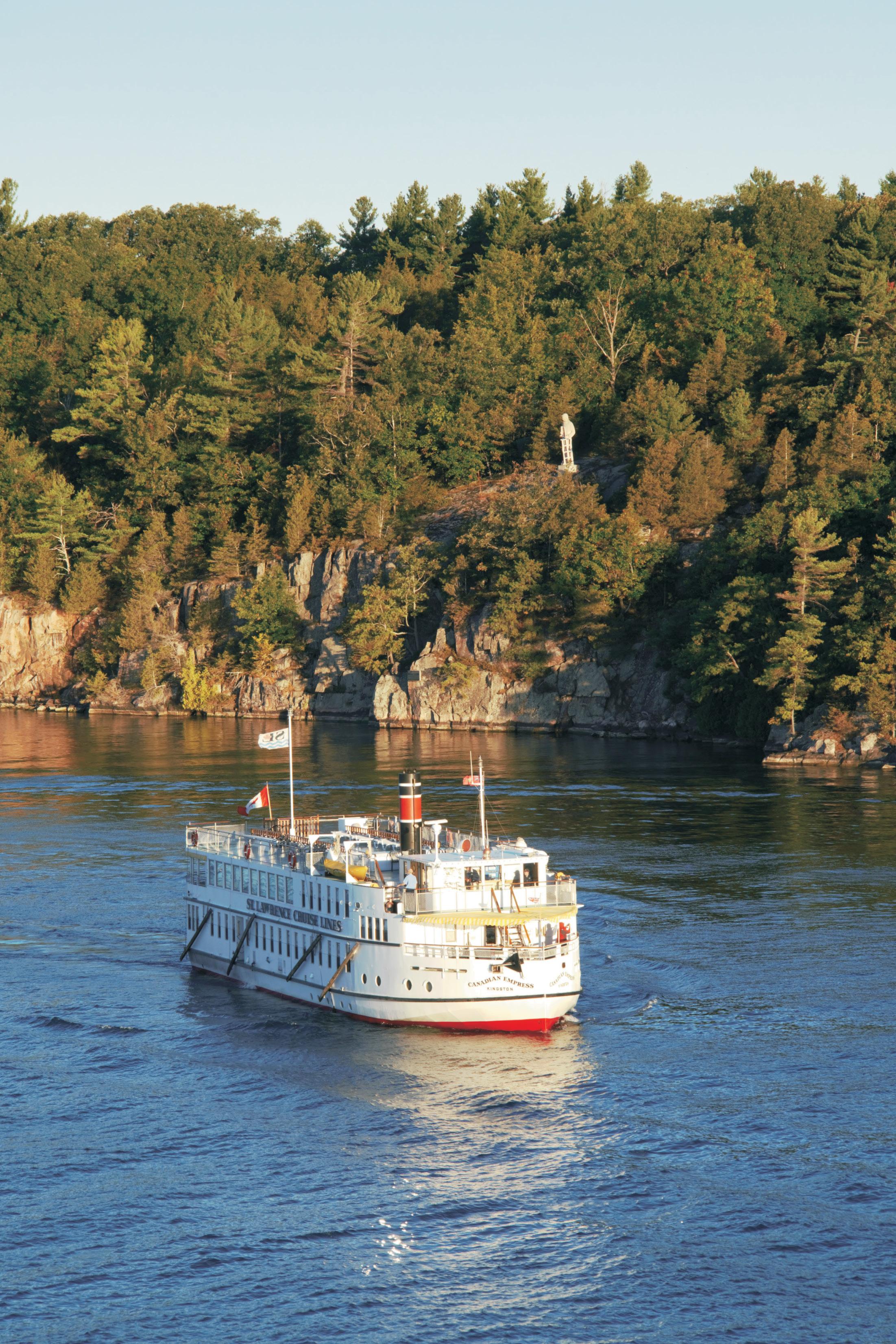
Flight cancelled at the last minute? Here’s how to salvage your trip and get the compensation you deserve
By Jeremy Freed | Illustration by Holly StapletonIT’S A SCENARIO no traveller wants. You get to the airport, navigate check-in and security, arrive at your gate on time— and find out your flight has been delayed for hours or, worse, cancelled altogether.
Take heart. You might not be able to prevent the occasional flight cancellation, but there are resources and actions you can take that will help ensure a flight cancellation won’t stop you in your tracks.
KNOW YOUR RIGHTS
Since 2019, the Canadian Transportation Agency’s Air Passenger Protection Regulations have helped ensure that passengers travelling to, from and within Canada are fairly compensated for flight delays and cancellations when the airline is at fault. These regulations— often referred to as “the air passenger bill of rights”—are currently being reviewed, and an updated version is expected later this year. Until then, here are some highlights from the current regulations to keep in mind.
• If your flight is cancelled last-minute, airlines are obligated to provide you with the reason for the cancellation. They must also inform passengers about the compensation and assistance they may be entitled to.
• If your flight is cancelled or delayed by three hours or more due to an issue within the airline’s control, you are entitled to compensation, and the airline must book you on another flight as soon as possible.
• If the airline can’t get you where you need to be or you’re not satisfied with the itinerary they offer, in most cases you are entitled to a refund.
If you’re travelling on an airline outside of Canada, keep in mind that air passenger rights vary from country to country. The International Air Transport Association (iata.org/en/youandiata/travelers/passenger-rights/) provides links to air passenger rights organizations in several regions and to a directory of Civil Aviation Authorities around the world.

Ready to take off? Follow these best practices from Wendy Paradis, president of the Association of Canadian Travel Agencies (ACTA), to help ensure that a last-minute flight cancellation won’t derail your travel plans.
INVEST IN TRAVEL INSURANCE
Before you go on your trip, it’s “absolutely essential to have travel medical, trip interruption and trip cancellation insurance,” says Paradis. In the event of travel disruptions, these insurance policies can make it easier to find another flight or receive compensation.
ARRIVE EARLY
If you’re travelling for a time-sensitive event, such as a wedding or a coach tour departure, plan to arrive at least a day ahead of time. “It’s much more relaxing,” notes Paradis.
PACK SMART Paradis’s advice is to pack your carry-on with a couple of days’ change of clothes, a fully charged phone and charger, valuables and medication—anything you’d need in case of lost luggage. And don’t forget to tuck in anti-boredom options such as iPads, games for kids and books, too. CAA
Learn about Air Passenger Rights (APR) and access resources at caa.ca/your-rights/air-passenger-rights.
And have a CAA Travel Consultant walk you through what to do if your flight is cancelled.

Used batteries contain toxic materials that can cause ecological harm if they end up in landfill, so they should never be thrown out. The Recycle Your Batteries, Canada! program makes it easy to recycle instead.
Just collect them in a non-metal container, protect the terminals with electrical tape, and drop them off at one of our 10,000 convenient drop-off locations. You can find them at major retailers and municipal depots.
Learn more at RecycleYourBatteries.ca


Drivers need to know a few maintenance essentials—and leave the rest to the professionals
By Matthew Guy | Illustrations by Guilherme HenriqueFOR MANY NEW DRIVERS, that licence is a ticket to freedom and an invitation to enjoy the open road. But the complex ins and outs of a vehicle may be intimidating. Here is some foundational knowledge to help build confidence on the road.
TIRED AND TRUE
Those four tires are the only part of your car in direct contact with the road. Making certain they’re in top shape—and as high-quality as you can afford—should be a priority. Watch for obvious damage caused by road hazards and make sure they’re inflated to the recommended tire pressure. Keep an eye on the treads for any odd wear pattern, which could reduce traction and indicate an alignment problem.
FLUID SITUATION
This is the lifeblood of your vehicle— engine oil, transmission fluid and coolant are vital for your car to function properly. Drivers of internal combustion engine (ICE) vehicles need to be familiar with key components under the hood. These include the filler cap and dipstick for engine oil and transmission fluid, as well as the coolant and windshield wiper fluid reservoirs. Find out where the battery is located and check it for signs of corrosion or bulging, especially if it’s more than three years old. Know how to read an engine oil dipstick or, at least, learn how to interpret dashboard indicators. And get into the habit of checking underneath your vehicle for any sign of fluid leaks.
LEADING INDICATORS
A car’s dashboard is home to a host of crucial information. Some warning lights illuminate in yellow or
A car’s dashboard is home to a host of crucial information
amber as initial alerts—i.e., reminders to keep an eye out for certain issues to be mentioned to your mechanic at a future service appointment. Other alerts, which may light up in red, are critical indicators of potentially serious problems— check the owner’s manual for clarification. Many vehicles are now equipped with a tire pressure monitoring system —the typical TPMS image on a dashboard is a yellow tire-like icon with an exclamation point.
BASIC MAINTENANCE
A clear view is imperative for safety on the road, so you should replace windshield wipers twice a year, before they wear out. Changing the windshield wipers is a relatively simple task (see QR code below). The counter assistant at your local parts store may offer to do it—watch closely and pick up a useful skill. Rely on your mechanic for oil changes, seasonal tire swaps and thorough maintenance checks. Finally, remember to refer to the owner’s manual and follow the recommended service schedule. CAA
Watch the video. Scan the QR code to see our YouTube video on how to change wiper blades. And if you have any questions for our automotive experts, call 1-866-464-6448 or email autoadvice@caasco.ca.




cdnbeef.ca


We all need to get dinner on the table – every day. Want more ideas? Scan the QR code above - cdnbeef.ca.









Cdnbeef.ca takes you to the Canadian Beef Information Gateway with over 400 recipes, all with videos and nutrition facts. In the Diet & Wellness section, recipes are organized according to common dietary preferences and health goals, like Bone Health, Diabetes Friendly, and more. This Diet & Wellness section was developed with a committee of independent dietitians. This handy resource can help you cook to suit your dietary needs and interests when it comes to beef. Be(ef) inspired at cdnbeef.ca. Get it. Bookmark it.




cdnbeef.ca

Award-winning author and CAA Member
David Bergen on his favourite writers, Winnipeg neighbourhoods and renovating between novels
By Nicole Keen Photography by Ian McCausland

What’s your favourite bookstore?
McNally Robinson in Grant Park. It’s a beautiful setting for browsing and it’s where I do my book launches.
You like to renovate a room in your home after you finish writing a book. Which room are you most proud of?
I redid the kitchen in 2016 and I think the design worked out really well. Renovating is very different than writing a novel—I get out of my head.
You once mentioned that shoes are your greatest extravagance. Do you have a favourite shoe store in Winnipeg?
I don’t have a favourite shoe store, but I do have a favourite cobbler, Hue Shoe Repair. He talks about going back to Vietnam and because I’ve lived there, we have a good rapport.
Is there anywhere else in the world where you’d like to live?
I think Canada is a great place to live— we’re very fortunate here. And, as much as I complain about the weather, there’s something about Winnipeg that is very dear to me. It informs my writing in many ways. And it feels like a strong place, so I like it very much. It’s a place with a point of view.
Are there any spots in Winnipeg that have sentimental value?
DAVID BERGEN HAS A WAY WITH WORDS. His most recent novel, Away from the Dead, was longlisted for the Scotiabank Giller Prize, and he brought home a Giller in 2005. For the past 45 years, minus a few years in Southeast Asia, Bergen has called Winnipeg home. It’s where he finds community, the best cobbler and plenty of opportunities to write.
If you could meet any writer, living or dead, who would it be? Anton Chekhov. His short stories were such beautiful little gems. I’d love to sit him down in my home by the wood stove and give him a shot of something and just listen to him.
I think Canada is a great place to live— we’re very fortunate here
My wife and I have lived in Wolseley since we started out. Wolseley is a sweet little place full of writers and artists. Someone once said to me, “You live on writer’s block.”
Away from the Dead is set in Ukraine in the early 20th century. If time travel was possible, is there a certain time you would visit?
I think nostalgia is a bit dangerous and we tend to romanticize a different time. So, I think I would stick to the here and now. CAA









Now you can finally have all of the soothing benefits of a relaxing warm bath, or enjoy a convenient refreshing shower while seated or standing with Safe Step Walk-In Tub’s FREE Shower Package!
✓ First walk-in tub available with a customizable shower


✓ Fixed rainfall shower head is adjustable for your height and pivots to offer a seated shower option

✓ High-quality tub complete with a comprehensive lifetime warranty on the entire tub
✓ Top-of-the-line installation and service, all included at one low, affordable price
Now you can have the best of both worlds–there isn’t a better, more aff ordable walk-in tub!
Call today and receive a FREE SHOWER PACKAGE













From baby porcupines to singed ravens, Prairie Wildlife Rehabilitation Centre cares for Manitoba’s injured wildlife one quill (and feather) at a time
By Kate Rae | Photograph by Thomas FrickeLIKE SO MANY YOUNG KIDS, Lisa Tretiak grew up wanting to help animals, although the idea of working with just dogs and cats didn’t appeal. She thought it would be way more fun to work with wild animals that weren’t owned by anyone. “I wanted to figure out how to get them back out to the forest and not have to rely on humans.”
Tretiak went on to volunteer with a wildlife rescue and, in 2007, teamed up with a group to start Prairie Wildlife Rehabilitation Centre, located 12 kilometres south of Winnipeg. The centre focuses on helping injured wildlife, like squirrels, rabbits, birds, ducks, bats and deer. Right now, after winter’s quiet season (thanks to hibernation and migration), PWRC is entering its busy time, and Tretiak estimates that, by June they’ll have over 175 animals in their care.
Cats and cars cause the most common injuries to the wildlife that are brought in and assessed. “We do first aid on the animals, whether it’s cleaning the wound or stabilizing a broken wing or leg before we take them to a veterinarian, if needed,” says Tretiak, who also employs homeopathy to assist animals experiencing stress, anxiety and fear.
Education and outreach are crucial, not only to try to prevent injuries, but also to educate the public about normal wildlife behaviour. The staff gets a lot of concerned calls, for example, from people who find bunnies that they think were abandoned. But for undomesticated animals, it’s important to scope out the situation, as moving them may cause more harm than good. Tretiak notes that it’s normal for
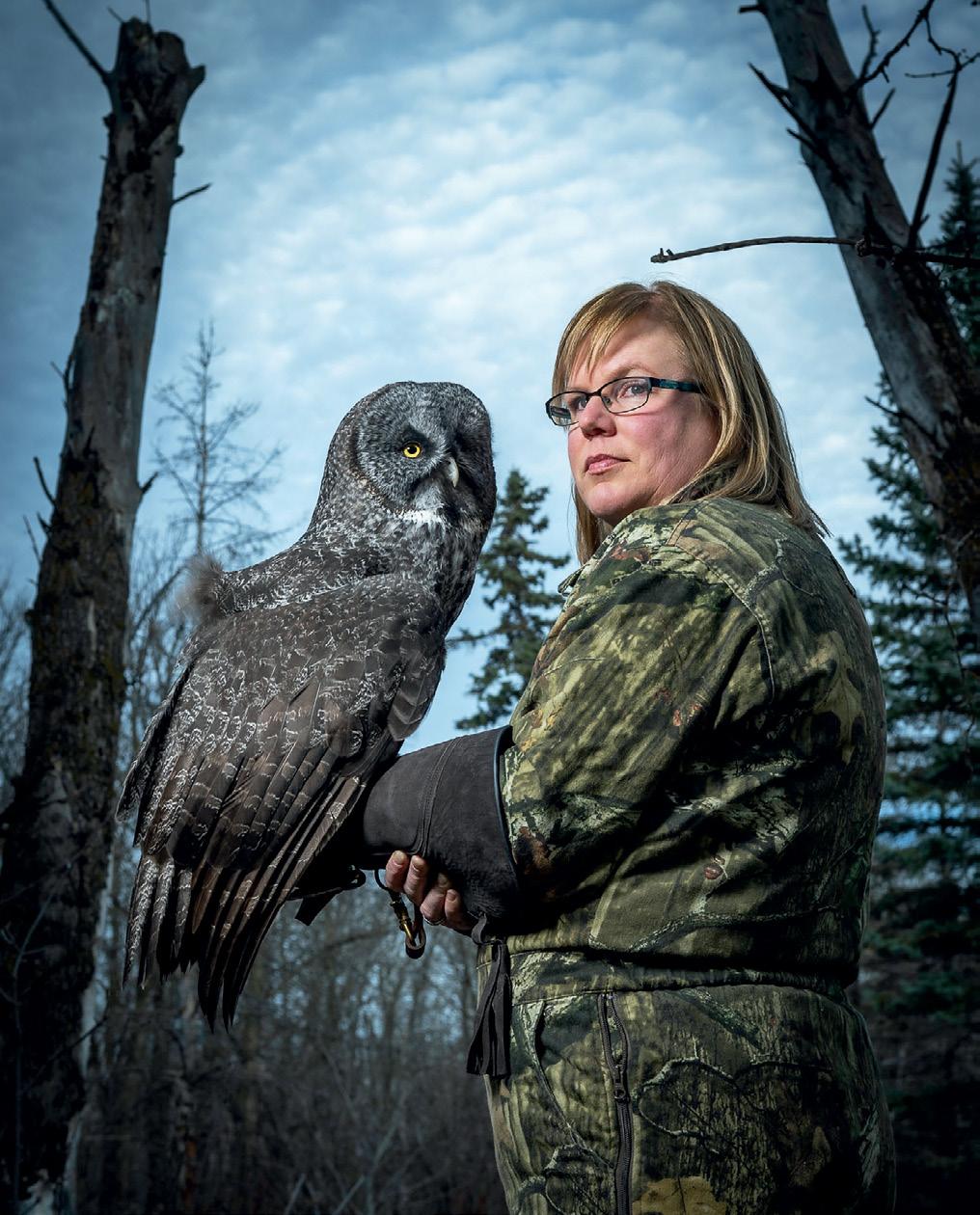
wild-rabbit parents to feed their babies and then leave them on their own for the rest of the day.
I wanted to figure out how to get them back out to the forest and not have to rely on humans
Over the years, there have been many heartbreaks (“Rehab isn’t for the faint of heart,” Tretiak warns) as well as success stories, including a pregnant injured porcupine who gave birth at the centre, and the electrocuted raven whose feathers all grew back after care.
One of the most important elements of wildlife rehab is to make sure the eventual release process is successful and that the animals still view humans as threats. “Camouflage outfits and masking spray does it. I’m lucky my husband puts up with my craziness,” Tretiak says, laughing. “Most of my days end with a long hot shower.” CAA
Do you know of a Good Place? We want to celebrate community organizations that strive to make life better for all. Send nominations to drivenbygoodmb@caamanitoba.com to share their stories.
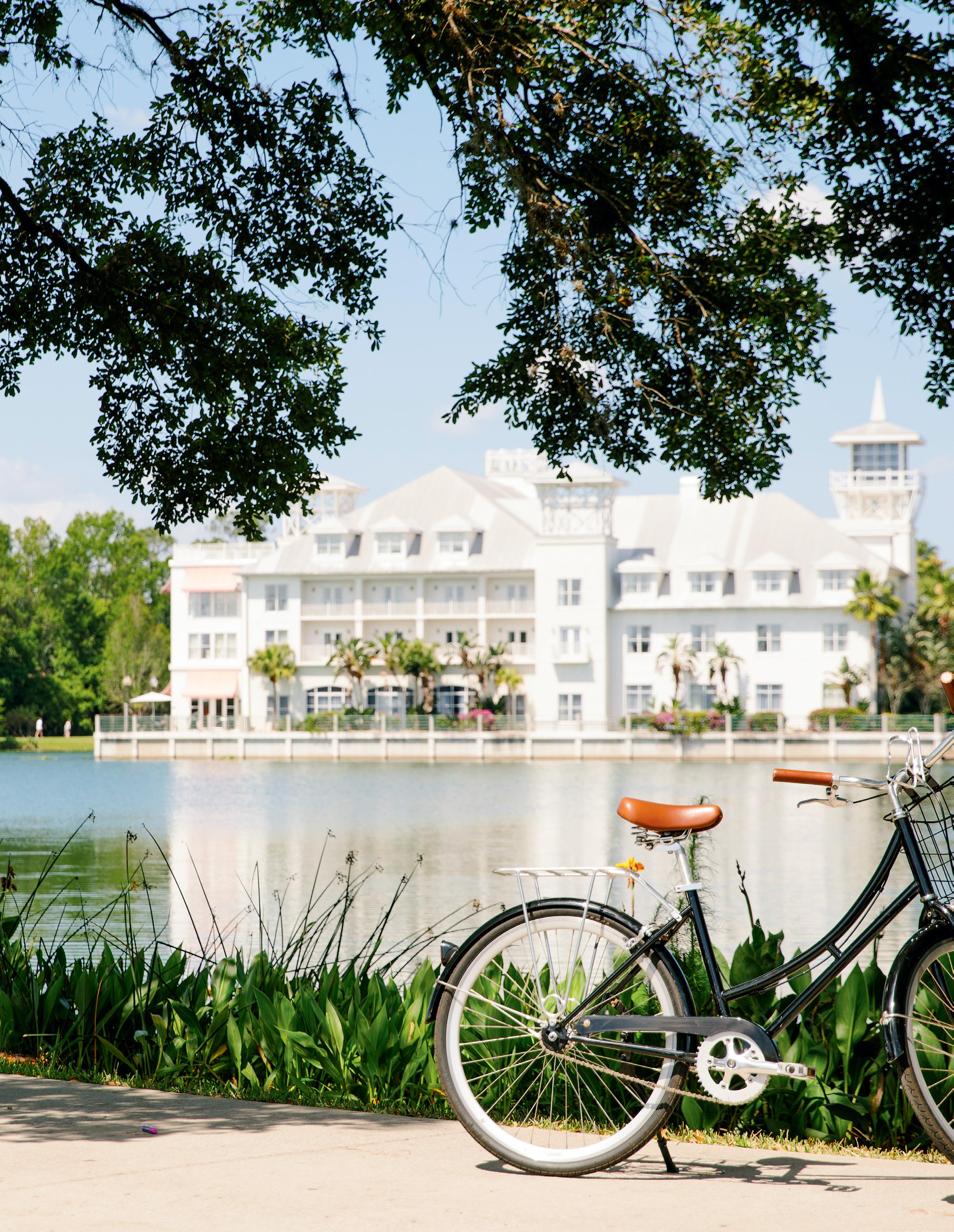

IMAGINE STARTING YOUR DAY with breakfast poolside at a resort in Orlando and, by noon, you’re feeling the warm breezes of South Florida, in Palm Beach, Fort Lauderdale or Miami. It’s easier than ever with Brightline, Florida’s sleek highspeed passenger train, which has launched its eagerly awaited new route connecting Central and South Florida.
With trips from Orlando to Miami in just 3 1/2 hours, Brightline whisks you through the Sunshine State, but the journey is about much more than getting there quickly. On this environmentally friendly biodiesel-electric train service, you can reduce your carbon footprint while experiencing the timeless luxury of low-stress train travel—in this case, with cushy hand-stitched leather seats, full windows for contemplative gazing and free mimosas for Premium guests. Just sit back and enjoy the scenery—Florida’s famous citrus groves, bountiful wetlands and other glorious landscapes that change with every passing mile.
(This page)
The interior of a Brightline smart coach. (Opposite page) The Celebration Hotel in Kissimmee is next to the lake and trails for walking and biking.

After landing in Orlando, I could have hopped on the Brightline since it has a stop right at the airport, but I decided to take some time to explore Kissimmee first. My base was the Celebration Hotel, with its architectural nods to turn-of-thecentury Florida—lined with picket fences—in an area known for its picturesque American-small-town vibe, including an idyllic view of Lake Rianhard from my balcony.
The quaint streets of Celebration Town, a community originally developed by The Walt Disney Company in the 1990s, unfolds like a storybook village, and the serene lakes and sprawling wetlands of Osceola County beckon for a quiet kayak trip and glimpses of wildlife.
Gatorland This 110-acre family-owned park and wildlife preserve south of Orlando doubles as a refuge for relocated wild alligators. The park features a heart-pounding zip-line track that soars over alligator breeding marshes, teeming with hundreds of the so-called swamp puppies.
Paddling Center at Shingle Creek Glide under a canopy of stunning cypress forest, past banks brimming with wildlife (including herons, turtles and alligators), while learning about the creek’s rich history.
Cirque du Soleil’s Drawn to Life At Disney Springs, experience a world where animation and acrobatics intertwine in a performance featuring rhythmic gymnasts, animated drawings and aerialists.
Salt & The Cellar This restaurant, located in the luxurious Ette Hotel, is helmed by Michelin-starred chef Akira Back. Don’t pass on his signature tuna pizza. Note that the Ette is a dry hotel (BYOB still welcome), but its dramatic zeroalcohol cocktails showcasing fresh botanical ingredients are delightful alternatives—picture a fairytale forest scene in drink format.
Columbia Restaurant Renowned for its 1905 Salad—tossed table-side with ham, Swiss cheese, olives and the signature garlic vinaigrette—and for its saffron-infused paella, this oldworld restaurant balances traditional Spanish and Cuban recipes with Floridian flair. Other dishes of note are the Devil Crab Croquettes and Original Cuban Sandwich.
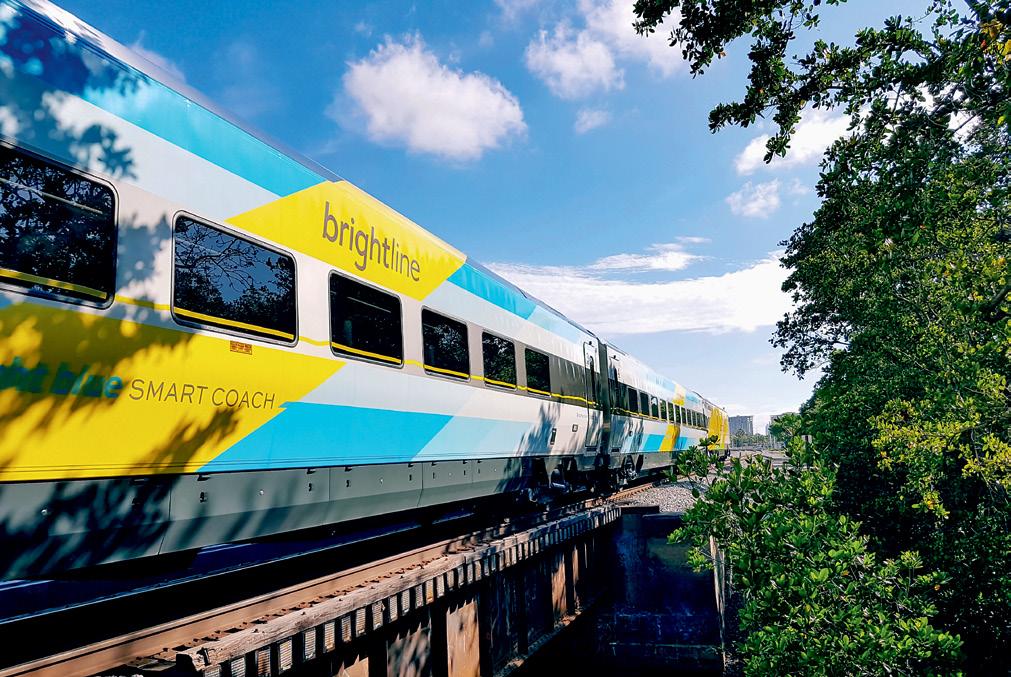
(From top) A Brightline biodieselelectric locomotive; “The Inner World of Animation,” an act from Cirque du Soleil’s Drawn to Life; kayakers enjoy a guided nature tour with the Paddling Centre at Shingle Creek.

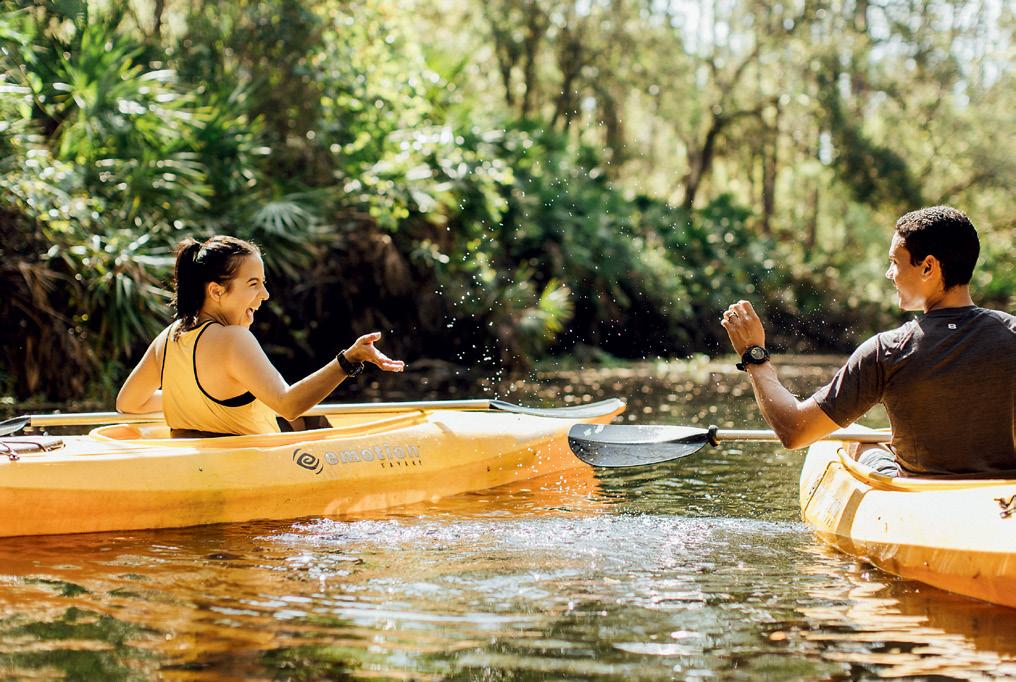
Orlando may be the theme park capital of the world, but there’s plenty more to see in the aptly nicknamed “City Beautiful.”
Slather on the sunscreen and head to Wekiwa Springs State Park. Paddle past stately homes on a kayak tour with Adventures in Florida to learn about the wildlife and history of the local waterways.
Browse more than 180 shops in the airy galleria of the Orlando International Premium Outlets on International Drive. Hot tip: Pick up souvenirs at the Disney Character Warehouse, which offers licensed products at clearance prices for much less than what you’d spend at the Park.
The trendy community of Lake Nona is home to Boxi Park, an open-air food hall with stalls constructed from repurposed sea containers. Sample the creative bites and beverages on offer at the numerous food stalls.
The Orlando Magic generally play 41 home games at Amway Center each season. Ticket holders can create their own VIP experience before or during the NBA games with a buffet dinner at Jernigan’s, which overlooks the arena.
Take in a concert at Steinmetz Hall in the Dr. Phillips Center for the Performing Arts. This elegant state-of-theart facility features acoustics engineered to blow you away.

Treasure Coast Sailing Adventuresʼ newly restored sloop, Resolute, can accommodate up to 12 passengers for sailing trips in Martin County.
Back at the new bright and airy Brightline station at Orlando’s airport—with its cocktail bar and well-stocked market and gift shop—you can reach West Palm Beach in just over two hours. West Palm offers high-end shopping, art and a standout culinary scene, but I headed to Martin County for a more relaxed and small-town experience. Explore the Treasure Coast, starting with a stroll on Stuart's picturesque Riverwalk. I stayed at the Old Colorado Inn, which is comprised of several charming properties in downtown Stuart. Accommodations range from boutique hotel rooms in the main inn to quaint cottages and distinctive homes—including the historic Owl House, a 1904 riverfront home with five bedrooms and a private outdoor spa. All of the inn's properties are steps away from lively shopping and dining venues and the scenic St. Lucie River.
Treasure Coast Sailing Adventures Set sail from Stuart on one of its classic vessels that can be chartered for small or large groups. Join one of their daily group sails, create your own custom charter to visit the nearby sandbars or opt for a deepwater cruise to the Indian River Lagoon estuary, home to pelicans, osprey, eagles and dolphins.
Riverwalk Cafe and Oyster Bar Nestled by the St. Lucie River, this restaurant is a Stuart local favourite with its fresh oyster bar and specialties, such as oysters Romanoff (a.k.a. “dirty oysters”) served with sour cream, shallots and caviar, complemented by an extensive list of 120 wines, 50 of which are sold by the glass.
Hobe Sound Marvel at the unique limestone formations of Blowing Rocks Preserve and relax on peaceful Jensen Beach. A dolphin-spotting walk in Hobe Sound’s Peck Lake Park is just one of many free eco-tourism events available in Martin County.
ORLANDO
Tampa (future development)

WEST PALM BEACH
Boca Raton
Miami Central FORT LAUDERDALE
Aventura

Although you can take the Brightline route all the way to Miami, my final stop was Fort Lauderdale, often called the “Venice of America” for its extensive canal system. It’s a destination made popular by its crystal-clear waters, white sand beaches and buzz-worthy restaurants. A water taxi journey provides glimpses of the lavish yachts and luxurious mansions of Millionaires Row.
The modern all-suite Hilton Fort Lauderdale Beach Resort was my home base here and I could have stayed there all day to enjoy the pools and private cabanas, set against a wraparound deck framing the ocean views. But there was still so much more to see. The resort is a stone’s throw from the beach and Las Olas Boulevard, where you can stroll through historic districts, browse chic boutiques and explore art galleries. Also on offer are complimentary bicycles to tour the area’s many hiking and biking trails.
Dune by Laurent Tourondel One of the few restaurants on Fort Lauderdale beach, Dune is led by its French Michelinstarred chef namesake and is a highlight of the city’s burgeoning dining scene. The menu melds Asian and Mediterranean influences, with specialties such as toro nigiri with lemon glaze and a stand-out branzino filet with fennel and artichoke.
La Fuga Tucked in the Kimpton Shorebreak Resort, La Fuga with its coastal Italian flair has an indoor-outdoor dining room within view of the rooftop pool. Begin with a skillfully crafted Negroni, then try one of the handmade pastas, such as the tagliatelle al ragu Bolognese or lobster ricotta ravioli.

Flamingo Gardens You could spend a full day wandering through this 60-acre sanctuary, featuring thousands of exotic plants, ancient trees and one of the largest collections of wading birds in America (including flamingoes, of course). The gardens also include a habitat where you can watch rambunctious river otters play. Don’t miss the 1930s Wray Home Museum and narrated tram tours through the historic oak trees and tropical groves.
CLAIRE SIBONNEY is a freelance travel and lifestyle writer and editor whose work has appeared in National Geographic, Self, Teen Vogue, InStyle and other publications. Sibonney teaches journalism at Centennial College.
(This page) A Caribbean flamingo fishes in the pond at Flamingo Gardens. (Opposite page, from top) A map of Brightline’s route and station stops; The Ocean Deck dining patio at Dune in Fort Lauderdale.
On my flight home, my mind is filled with the beautiful sites I enjoyed—and a few new discoveries I caught a glimpse of as I whizzed past them on the train. Thanks to the convenience of the Brightline, I know that on the next trip, these and many more unexplored stops are just a short ride away. CAA
Don’t forget travel insurance. CAA Travel Insurance includes options that cover emergency medical and dental care, lost baggage and changes to your trip. Visit caamanitoba.com/travelprotected to get a quote.
A CAA Travel Consultant can help you plan the perfect Florida getaway. Visit caamanitoba.com/travel to learn more. PHOTOGRAPHS: (THIS PAGE)
Travel cross-country to sample Japan’s delectably diverse cuisine, from humble street foods to delicacies fit for an emperor
By Corrina Allen Illustrations by Romane Mendes
IN MY PAST THREE TRIPS to Japan, to the main island of Honshu, I’d never had a bad meal. I’d slurped down shoyu (soy sauce) ramen in Tokyo and enjoyed a traditional tea ceremony in Kyoto. Each dining experience revealed something vital about the culinary culture and traditions of the country.
This time, I’m headed for delicious destinations a little farther afield. I joined tour provider Oku Japan alongside a small group with adventurous palates and travelled southwest, to Osaka and Awaji Island, then north to tiny Nanto, near the Sea of Japan.
ROYAL PROVISIONS ON AWAJI
Many chefs adhere to the idea that diners eat with their eyes first, and in Japan, this is apparent on every plate—food is beautifully arranged and presented, or packaged. Care is an elemental ingredient in Japanese cuisine, as essential as tea, rice, fish and soy. Nowhere was this more evident than on Awaji Island, on the Seto Inland Sea.
The serenity of this sleepy resort area overlooking Osaka Bay belies its hardly humble culinary legacy. Considered a mitsukekuni (roughly translated as “region of food”), Awaji Island has long been a source of premium beef, seafood and other luxury ingredients for dishes once served at the ancient imperial court in Kyoto.
More recently, in Sumoto, a city on the east coast of Awaji, chef Satoru Shinsei
served our group a feast fit for royalty— grilled fish with satoimo (Japanese taro root), a seasoned carrot terrine and panseared mackerel partnered with roasted shallots and fresh figs. We also sampled the island’s famed beef—mild, slightly sweet and liberally marbled with fat.
His restaurant, Shoku No Wa, is so named for his culinary philosophy, one he describes as focused on “food harmony.” By reinvigorating traditional cooking techniques with innovative twists, he’s been credited with sparking a culinary renaissance on Awaji, which now boasts several upscale restaurants as well as luxury accommodations.
Before sitting down for his threecourse meal, we’d spent the morning watching fish-laden boats dock at the local market for auction. We’d also visited a small fish-processing shop to see the delicate work required to debone Japanese cutlassfish, or tachiuo. Our meal at Shoku No Wa was the culmination of all this meticulous labour and rich culinary history. Each dish was a visual and gastronomical celebration of the seasonal ingredients the island has to offer.
Each dining experience revealed something vital about the culinary culture and traditions of the country

On clear days, you can see Osaka from Awaji, but culturally and aesthetically, it’s a world away. The heart of its seafoodcentred food scene is the busy, buzzing Dotonbori district. Surging with tourists, lit with neon and adorned with giant animated signs, Dotonbori is crowded, loud and one of the most exciting places to eat in Japan.
Takoyaki (grilled octopus balls topped with Kewpie mayo, green onion, and bonito flakes) is among Japan’s most popular street foods. Join the lineup outside the shop with the fivemetre-high 3-D octopus sign above the entrance. If you’re looking to sample

(From
some of Dotonbori’s freshest shellfish, head to Kani Doraku. You can’t miss it— visible from down the block, a giant mechanical crab, literally waving customers inside. There, at the takeout counter, I had one of the most memorable dishes of the trip—a piping hot nikuman (fluffy steamed bun), this one stuffed with
shredded sweet crab meat.
Takoyaki and okonomiyaki (savoury pancakes) shops dominate the district’s main arcades, but Kushikatsu Daruma Namba Honten entices with a hard-tomiss alternative. Under a massive statue of an angry-faced chef, this iconic eatery serves up skewers of deep-fried meat,
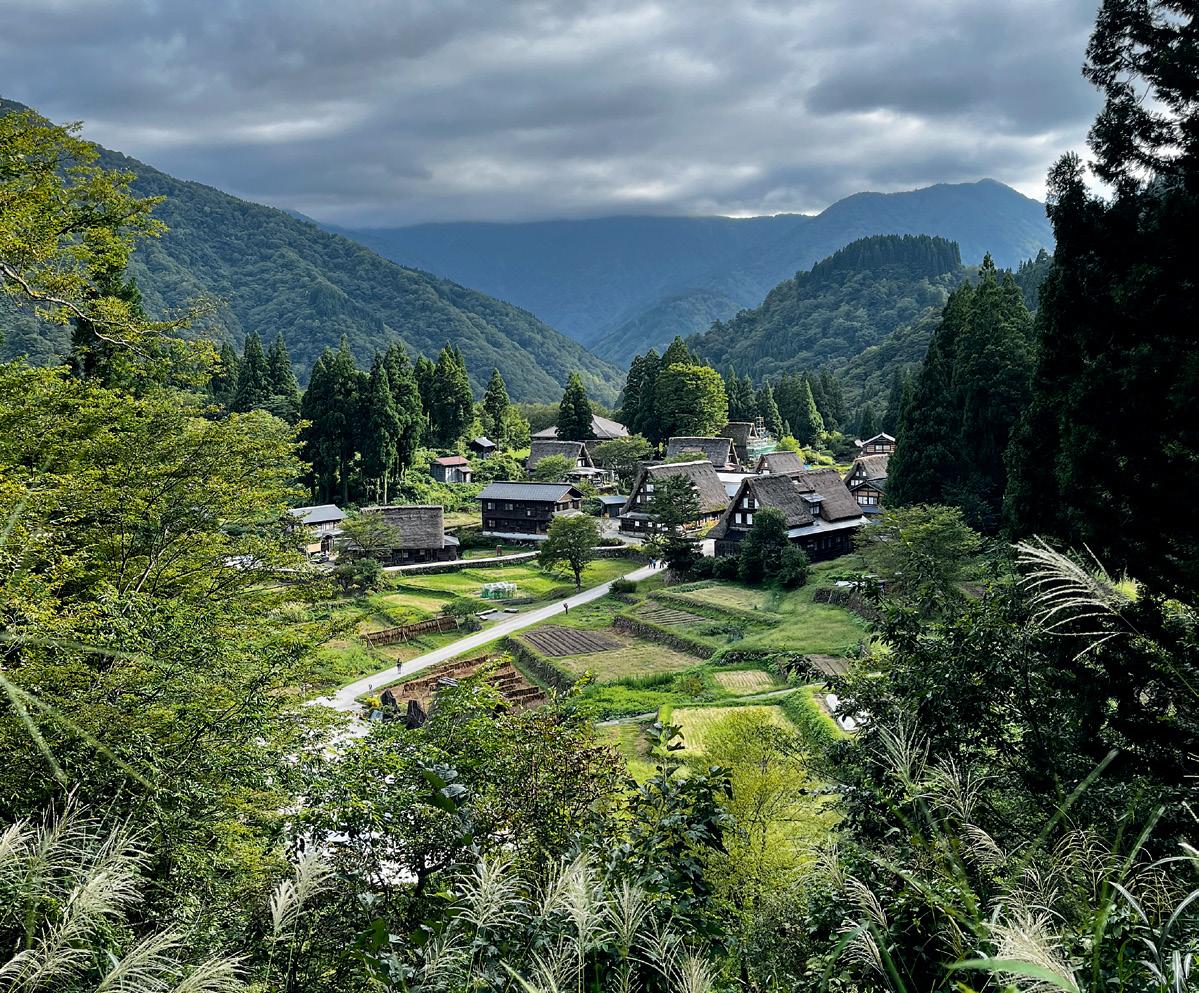

seafood and vegetables—kushikatsu, the perfect bar food. Add a pint of ice-cold Asahi and soak up the full experience. Osaka is a street food lover’s dream, with far more to relish than what you can fit into a week.
After a hike through the serene mountain town of Nanto, four hours north of Osaka by train, I’m excited to arrive at Yomoshirō, a small family-run inn of a type called minshuku Our hosts bring us towering bottles of frosty beer alongside traditional Japanese spreads. A draw for food lovers, minshuku provide meals as elegant as they are simple. Local specialties play a central role and, in Nanto, these would include the town’s famed fermented preserves that are prepared to last through harsh, snowy winters.
Once seated cross-legged on tatami mats, guests are offered fermented local vegetables, grilled or fried fish, and a silky cold tofu dish called hiyayakko. The second course is a bowl of flavourful miso soup, finished with a serving of plain white rice. For breakfast in Nanto, we were treated to umeboshi (pickled plums)—a flavour bomb of salty and sour that could be classified as an acquired taste.
But that’s entirely the point of my trip. I came to acquire new tastes, experience untested flavours and choose a new favourite dish—one more reason to return to Japan. CAA
CORRINA ALLEN is a Berlin-based Canadian writer covering travel, food and design trends. Her work can be found in The Globe and Mail, rePorter, Pivot and on Forbes.com
A CAA Travel Consultant can help you plan a delicious culinary adventure, including accommodations and restaurant recommendations. Visit caamanitoba.com/travel to learn more.
Many chefs adhere to the idea that diners eat with their eyes first. In Japan, this is apparent on every plate
From street food to sushi, Japan’s food markets and halls boast some of the richest culinary offerings

Show up hungry at this market in central Kyoto. Established as a marketplace in 1615, this 400-metre-long arcade is the best place to get a feel for the cuisine of the cultural capital of Japan. Must-try items include wagyu kushiyaki (skewered bites of premium-quality beef), tako tamago (tiny skewered octopus stuffed with a quail egg) and sweet tamagoyaki (a rolled omelette flavoured with rice wine and soy sauce).
Just a 20-minute walk from Shimbashi JR Station, Tsukiji is the destination for seafood enthusiasts. Formerly a wholesale fish market, it is also a draw for travellers wanting to try some of the city’s best sushi, sashimi, fresh oysters and fried fish cakes.

Department store chain Daimaru is legendary for its underground food halls (called depachika). The Tokyo Station location in GranTokyo North Tower features rows of snacking options, including a patisserie section that would impress even a Parisian. Try the strawberry-and-whippedcream sandwiches served on shokupan white milk bread that has the texture and consistency of a cloud.

































































































Save 20% on parking with your CAA card.
parkYWG.ca

Grab your binoculars—the migratory birds are back. Here’s how to welcome and nurture our feathered friends
By Andrea YuTHE SOUND OF BIRDSONG in spring is something that Yousif Attia looks forward to every year.
“Birdwatching is so therapeutic for me,” says Attia, an outreach and content specialist at Birds Canada, a national bird conservation organization headquartered in the lakeside town of Port Rowan, Ont. “At its core, birding satiates this human desire to connect with the natural world.”
And Attia is not alone. Since the pandemic, he has noticed a surge in birdwatching interest, particularly among millennials. “We’re seeing more people out there, especially folks from diverse backgrounds and people younger in age.”
For many birders, their pastime is a meaningful way to feel closer to nature and other people—which is especially significant for those who may feel marginalized. “If you see somebody your age or who looks like you and they’re birding, it gives you the feeling of ‘This is a place or a space I could be part of as well,’ ” notes Attia. In Vancouver, where he lives,
(This page)
Birds Canada's Yousif Attia (in white mesh hat) leads a local group on an instructive birding walk at Queen Elizabeth Park in Vancouver. (Opposite page)
An owl is fitted with a satellite transmitter to help the Manitoba Burrowing Owl Recovery Program gather migration data.
the group Birding with Me celebrates “diversity in bird and human communities.” They host free guided walks tailored to specific groups, including those who identify as BIPOC or 2SLGBTQ+. Birding with Me events are also offered in various languages such as Spanish, Mandarin and Filipino. Birdwatching is not just enriching for bird enthusiasts, it can also have a positive impact on the birds themselves. Apps such as eBird allow users all over the world to log bird sightings in their local communities, which contributes to conservation decisions and research. Initiatives such as the Great Backyard Bird Count—an annual event whose participants log the birds they see within a four-day period via eBird—can be done from home.
Having more birds around to admire is only one reason to help protect them. Canada has more than 420 bird species that face a host of issues, from a reduction in habitat due to forest degradation to shifting migratory patterns affected
While we love—and need—to have birds nearby, many hazards that they face stem from our homes and buildings. Here’s how you can help.
Keep your cats indoors or on a leash “Over a hundred million birds per year are killed by outdoor free-roaming cats,” says Jordan at Nature Canada.
Add window decals Window collisions account for 16 to 42 million bird deaths a year. Prevent bird strikes by applying decals on the outside of the glass.
Opt for a pesticide-free garden Pesticides kill bugs that birds depend on for food. “Sometimes, using your garden hose is enough to get rid of unwanted bugs,” Coulber notes. And when purchasing plants and seeds, ensure they have not been sprayed with neonicotinoids, a category of powerful neurotoxic insecticides.
Consider supporting these local organizations that help protect wild birds in your area
NATURE MANITOBA
Through field trips, special events and research groups, Nature Manitoba provides opportunities to appreciate and protect nature, including birdwatching outings in spring and fall. naturemanitoba.ca
MANITOBA BURROWING OWL RECOVERY PROGRAM
by climate change. Autumn Jordan, an organizer at the Ottawa-based environmental non-profit Nature Canada, describes birds as an indicator species, meaning “the biodiversity of our bird communities can really show us a snapshot of overall system health,” she notes. Some birds are pollinators, while fruit eaters help with seed dispersal. Birds also play an important role in the food chain. “Owls are natural rat-eaters, and scavengers like crows and turkey vultures clean up our messes,” Jordan explains. “Warblers and barn swallows keep those nasty mosquitoes at bay.”
There’s a lot we can do in our own backyards to attract and protect our feathered friends. For example, it can be tempting to clear out dead foliage, but Sarah Coulber, an education specialist at the Canadian Wildlife Federation, says dried long grasses are used as nesting material and leaf litter is a spot where the insects that birds feed on can gather. She encourages homeowners to find a balance between a manicured garden and a safe shelter for birds. “Maybe you can leave a back corner of your garden untidy.”
If using feeders to attract more birds to your yard, place them far from windows and bushes where predators can hide. Keeping bird feeders and bird baths clean is critical to help prevent the spread of avian flu. Coulber recommends cleaning them with unscented natural soap and water once a week.
Feeders are a supplemental food source, but birds rely on the greenery in your yard. “Native plants have coevolved with wildlife,” explains Coulber. “Our native plants bear fruit that has the right proportion of fat to sugar that birds need to either overwinter or migrate.”
Fill your outdoor space with a variety of beautiful native plants and flowers. If you build the right habitat, you won’t need to seek them out—the birds will come to you. CAA
ANDREA YU is a freelance journalist and a contributing editor at Toronto Life and Maclean’s. Her work has been published in The Globe and Mail and the Toronto Star. Her home base is in Toronto, but she takes every opportunity to travel and be in nature.
Manitoba's burrowing owl populations are making a comeback, thanks, in part, to this organization. Volunteers help install artificial burrows and survey wild owl populations. canadahelps.org/en/ charities/souris-river-watershed-district
PRAIRIE WILDLIFE REHABILITATION CENTRE
This organization cares for injured, orphaned, displaced and distressed wild animals, so that they can return to their native habitats. pwildlife.ca
Learn more about the centre on page 21.

who’s driving?
Driving Enthusiasts. Commuters. Savvy Savers.
Finding the right vehicle for you starts with being honest about your needs and how much you can afford
By Matt Bubbers Illustrations by Rami Niemi“WHAT CAR SHOULD I BUY?” is one of the most common questions Members ask CAA’s automotive experts. There’s no such thing as “The Best Car”—but somewhere out there is a best car for you.
Ryan Peterson, CAA’s manager of automotive services, boils down the shopping process to three steps. First, be honest about your needs. Second, make a shortlist of models that fit the bill. Third, test-drive them all because there’s no substitute for seat time.
“It’s about finding a vehicle that suits you and meets your needs,” Peterson says. That includes how you use your vehicle and, most important, what you can afford. Here, we break down some of the most popular types of vehicles and what kind of driver suits them best.

The Pros Sedans and hatchbacks are the most affordable, energy-efficient and maneuverable new vehicles on the road today—perfect for long commutes and drivers on a budget. Newer compact sedans have become large enough to comfortably seat adults in the rear seats, too. Sporty sedans and hatches can be fun to drive, feeling nimble, precise and playful.
The Cons Lower ground clearance means you’ve got to be more careful in deep snow. Some manufacturers arguably make their sedans too sporty, to the detriment of passenger comfort and everyday usability. Since sedans, hatches and coupes collectively make up only a small slice of the new-vehicle market, the selection of new models is not nearly as vast as it once was.

who’s driving?
Urban Families. Road Trippers. Value-Conscious.
The Pros Many drivers love that SUVs place them up high, which means less bending and ducking to get in or out. New parents (and their lower backs) will appreciate that the extra height also makes it easier to get a baby into a car seat. Mid-size SUVs are especially versatile, delivering enough passenger and cargo room for extended road trips and camping expeditions.
“SUVs have been exploding in sales since 2009,” says Andrew King, managing partner at Canadian auto-industry advisory firm DesRosiers Automotive Consultants. Their data suggests that SUVs (of all sizes) account for nearly 60 percent of annual new-vehicle sales. Given how versatile and easy they are to live with, that should come as no surprise.
The Cons SUVs are typically more expensive (by as much as $10,000) and less fuel-efficient than similarly sized sedans. Getting a model with all-wheel drive (AWD) often means stepping up to a more expensive trim level. While AWD does offer peace of mind, whether you really need it comes down to where you live, notes Peterson. He suggests that drivers in well-plowed urban areas are probably okay without it.

who’s driving?
Adventurers. Large Families.
The Pros If you prioritize maximum space and go-anywhere capability above all else, you need a big SUV. Many full-size SUVs offer spacious third rows and have the ground clearance to go where minivans can’t—in fact, SUVs with a third row of seats have effectively replaced minivans, whose sales are dwindling. Some big SUVs are based on a body-on-frame truck chassis, while others are based on car platforms. The former are often better off-road, while the latter offer a better, quieter ride for long commutes. These vehicles are great for true adventurers with families (or lots of friends) who need a powerful ride with space for everything from pets to people and outdoor gear to groceries. They are also good for cross-country or rough-road excursions and hauling heavy loads (boats, ATVs, snowmobiles). Luxe options abound.
The Cons They’re heavy and often have big, gas-hungry engines. They’re more expensive to purchase and to own than smaller SUVs or cars. Their sheer size means they’ll be busting out of downtown parking spaces and often have limited outward visibility, which isn’t ideal in areas with lots of pedestrian traffic. Shorter drivers may find some big SUVs too tall, making it difficult to get in or out.
who’s driving?
Skilled Trade Workers. Farmers. Outdoor Enthusiasts.

The Pros Pickups are more versatile than ever. It’s little wonder they account for roughly 23 percent of new-vehicle sales, according to DesRosiers’ data. Peterson says pickups are best for people who actually use them as trucks—for towing, hauling and getting work done—as well as for outdoor enthusiasts (with their toys) who need to get to remote spots. “Most contractors ‘under-buy’ on their trucks,” he says. In other words, if you’ll often be using the upper limit of a truck’s payload or towing capacity, consider stepping up to a bigger truck.
The Cons Despite technological advances, pickups still aren’t as comfortable as cars and smaller SUVs. They’re not fuel-efficient either and so, not ideal for commuters. Plus, the tall, blunt front ends on many trucks pose a greater risk to pedestrians in the event of a collision, according to a recent study by the U.S. Insurance Institute for Highway Safety. CAA
Due to supply shortages leading to higher car prices, along with rising interest rates, average car payments were $800 to $1,000/month in 2023, says Rob Carrick, personal finance columnist at The Globe and Mail. Carrick suggests choosing a car or truck that limits monthly payments to $500 or $600 with a five-year-maximum loan term.
Which type of engine is right for you depends in large part on how far you drive daily
Even new entry-level EVs can travel more than 400 kilometres between charges. But since batteries are expensive to produce, EVs carry a price premium. If you drive a lot, the fuel savings will likely make up for the additional purchase price, so it pays to do the math. Having a parking spot to plug in and recharge your vehicle overnight isn’t strictly necessary—you could rely on public chargers—but it makes EV ownership much, much easier.
Plug-in hybrid vehicles (PHEVs) can typically travel 30 to 60 kilometres on battery power before their gasoline engines kick in. They’re versatile—great for short weekly commutes and long-weekend road trips— but don’t excel in any one area. Mild-hybrid electric vehicles (MHEVs) can’t be plugged in and don’t have much (or any) electriconly driving range, but they deliver consistently good fuel economy. “If you’re driving on the highway all the time, a hybrid’s not going to do a whole lot of good. It helps reduce fuel consumption a little bit. But if you drive in the city, they help a lot,” says Ryan Peterson, CAA’s manager of automotive services.
These vehicles need no introduction. They’ve been around for over a century. Gas and diesel engines are still the best if you regularly tow heavy loads over long distances.
MATT BUBBERS writes regularly for CAA Magazine, specializing in car culture and transportation. He is a columnist for the Drive section of The Globe and Mail and writes for a variety of publications in Canada and the U.S.
When it rains, we shine.
There’s nothing gloomy about rainy days. That is, when you have WeatherTech FloorLiners. Laser measured for your specific vehicle, the WeatherTech FloorLiner is guaranteed to provide a perfect fit and the ultimate carpet protection, for as long as you own your vehicle. So when Mother Nature is at her worst, don’t worry because we’re at our best.



Learn the common causes of age-related hearing loss


From the melodies of an orchestral performance to the timbre of your grandchild’s rst words, there are so many precious moments in life linked to sound. Clear hearing can contribute to a higher quality of life, making it even more important to protect, as you age. Presbycusis—gradual hearing loss in both ears—is a common age-related condition that a ects one in three adults over 65. Understanding the common factors behind presbycusis can help maintain auditory health.
The sensory hair cells that live in the cochlea—the vital part of your inner ear that senses sound—are what carry information to your brain. These hair cells can be damaged by repeated exposure to loud noises, and studies indicate that the damage is irreversible even after noise exposure ceases. Research also shows that smoking is associated with hair-cell damage.
Age-related hearing loss may also run in your genes. If there is a history of presbycusis in your family, chances are it may increase your risks.
While science continues to examine the relationship between hearing and diet, nutritional de ciencies can contribute to presbycusis. In fact, according to a study published in The American Journal of Clinical Nutrition, a diet rich in vitamins A, C and E—in combination with magnesium—may reduce the risk of hearing loss.
Access exclusive o ers with your CAA Membership: savings of up to $2,000 on Select-level Sonova hearing technology* 5 years of free hearing-aid batteries with the purchase of a hearing aid 15% o everyday-listening products
Has your hearing gotten worse?
Regular hearing checkups are as crucial as visits to the eye doctor and the dentist. Take control of your health and well-being by scheduling a free hearing test at a Connect Hearing location near you.


Book your hearing evaluation today. Visit connecthearing.ca/CAA or call 1.888.486.0177.


This season feels like new beginnings—for our communities, our homes and ourselves. Read on for tips on eco-friendly gardening, bike safety, tuning up your vehicle, refreshing your home and more.
Welcome to spring!

Breeze into the season with these spring-cleaning tips
A THOROUGH CLEANUP—done right—makes your home feel more inviting and helps maintain a healthier, less-stressful environment. Here are a few pointers to get your place back in tip-top shape.
Step 1 It’s overwhelming to declutter the whole house all at once. Establish a sorting system using bins and put items in them throughout the year.
Step 2 Categorize your bins—one for items to be donated, one for things that are repairable and one for recyclable stuff not picked up curbside.
Step 3 Empty your bins each spring, scheduling one big trip to your local thrift shop and recycling depot.
Dishwasher
Clean the filter of any debris (think popcorn), then sprinkle one cup of baking soda in the bottom of the machine and run it through a cycle to handle stains and keep it fresh.
Clothes washer, dryer
Wipe the inside of your washing machine to prevent mould due to moisture. Vacuum the dryer lint trap and in and around the vent hose, as lint buildup can be a fire hazard.
Furnace
Change furnace filters every three (or even two) months. A clean air filter is better able to trap contaminants, so you can breathe freely. It takes just a minute to do the job.
Refresh your newly decluttered space with simple changes like an accent wall, painted furniture or new throw pillows from Bouclair. Or use a fresh coat of paint to help brighten things up. Limitless, the Dulux 2024 Colour of the Year, is like liquid sunshine and pairs well with wood tones and brass or bronze fixtures.
Show your CAA Membership Card in-store and get 25% off the regular price of all Dulux paints.
Members can use their CAA Membership to get perks shopping online. Visit caamanitoba.com/estore to learn more.
HERE’S GOOD NEWS for the lazy gardener. Sometimes, doing less makes for a more pollinator-friendly yard, says Ryan Godfrey, community action specialist (and resident botanist) at World Wildlife Fund Canada. Skip these four tasks to maintain a garden that’s more welcoming to beneficial insects, birds and animals.
Leaf blowers 0, pollinators 1
Make things more appealing for the tiny pollinators that overwinter in leaf piles in your yard. Godfrey suggests leaving fallen foliage until mid-to-late May when insects, including some bees and beetles, have emerged. If you’re worried the leaves will smother your lawn, gently rake them onto garden beds where they’ll insulate roots and eventually decompose, adding nutrients to the soil.

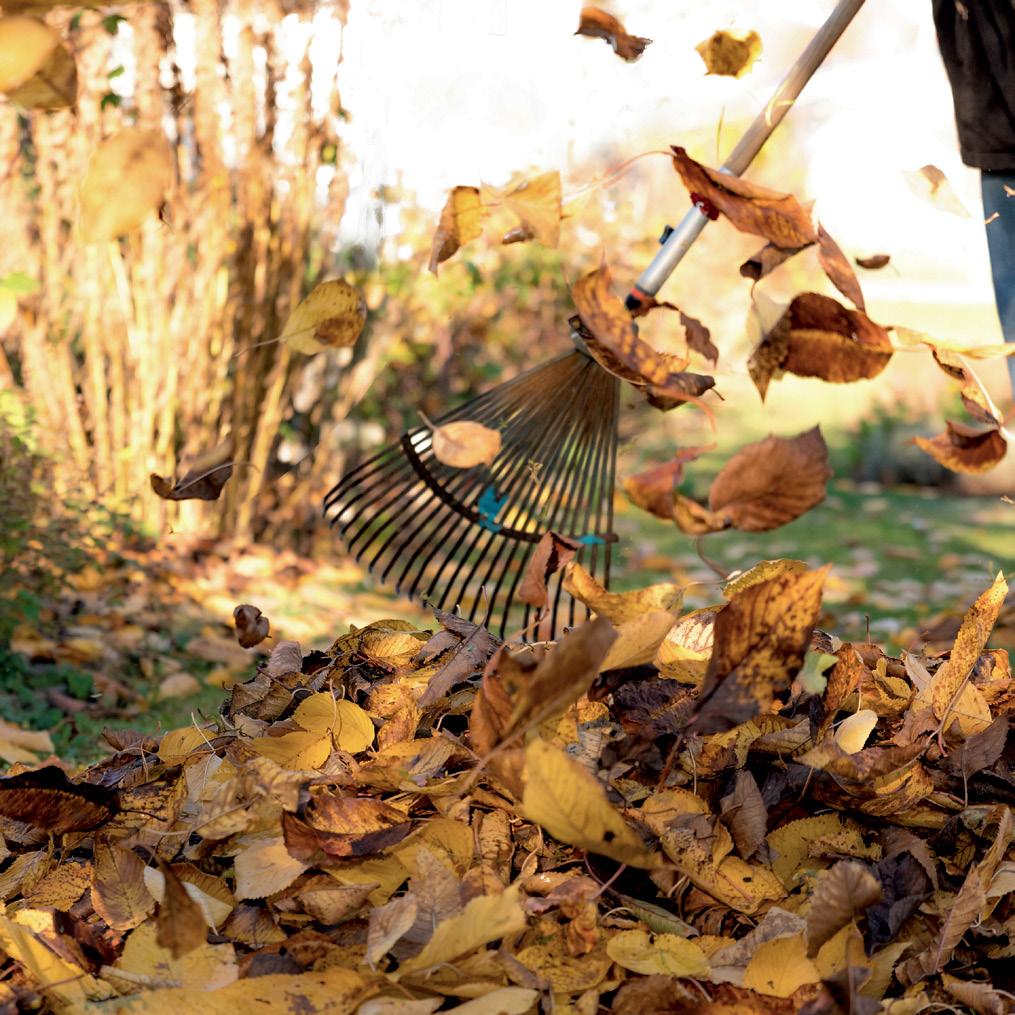
Chemical fertilizers out, compost in Most decorative gardens have what they need without fertilizer, unless your soil is macronutrient-deficient. All you often need, Godfrey notes, is a light sprinkling of compost to boost the soil’s nutrient levels and add trace minerals not found in synthetic fertilizers.
Most people have more lawn than they actually use, says Godfrey. He recommends converting some lawn space into a low-maintenance native wildflower garden or opt to keep the grass, but allow some biodiversity. Consider leaving at least some dandelions and clover—they’re a food source for pollinators. Bonus: you’ll spend less time weeding.
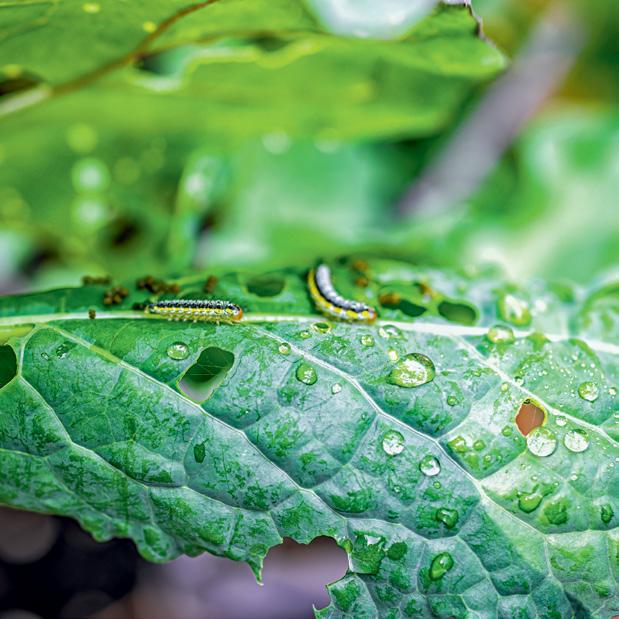

Are bugs eating holes in your plants? “That’s actually a sign that your plants are contributing to biodiversity,” notes Godfrey, who thinks most gardeners worry too much. If your plants become infested or are attracting invasive species, try a more natural deterrent before using a pesticide that kills both unwanted and beneficial insects indiscriminately. He suggests soapy water to remove aphids, and a copper wire barrier to deter slugs. To catch invasive Japanese beetles, consider pheromone traps (available at most hardware stores), which utilize chemical substances secreted by insects to affect the behaviour of other insects.
Visit caamanitoba.com/earnmore to get perks at well.ca when buying outdoor-living and gardening supplies.

THE SUN IS SHINING. It’s time to get moving—that is, let’s get our bodies and minds moving. This is what Joanna Marra, director of wellness at CAA Club Group, suggests. “People think about activity as being good for their physical bodies, but it’s also really good for increasing our mental clarity, increasing our energy levels and relieving some stress.”
Here’s Marra’s advice for getting yourself into a positive movement routine.
Just walk Fitness doesn’t need to be an exhaustive workout. “A lot of people find movement—walking—to be a form of meditation,” says Marra. “Just focusing on the walk or whatever movement you’re doing makes you feel really good.”
Enjoy it “Research shows us that if we do something we love, we’re more likely to want to do it again,” she notes. This could be swimming, pickleball, walking with friends or something that might not even feel like exercise, such as gardening, birdwatching or playing fetch with your dog.
Make a note Especially for desk workers, a reminder can help get you moving. “Sometimes the day slips by us,” she says, “but if you have something scheduled, you are more likely to do it.”
Physical and mental fitness is about feeling good, Marra points out. “Taking time to step outside and remove ourselves from whatever work we’re doing provides us that moment to disconnect and reconnect with ourselves. And then, when we get back to work or whatever it is we’re doing, we’re in a better space.”
Visit caamanitoba.com/earnmore for all your wellness needs and wants—from sunscreen to activewear.
A few reminders for the fast-approaching allergy season
Springtime—it’s finally here. For many, it’s time to get outdoors and enjoy the warmer weather. But for others, the joy of getting outside is curtailed by seasonal allergies.
The most common allergy symptoms range from coughing, sneezing, itchy eyes and a runny nose to hives and rashes—and they can start as early as February in some regions of Canada. The season starts with tree pollen, followed by grass pollen in spring and summer. Ragweed is the biggest culprit in summer and fall, but watch out too for burning bush, cocklebur, lamb’s quarters, pigweed, sagebrush, mugwort and Russian thistle.
Before you take a pass on outdoor pastimes, though, try these helpful symptom fighters:
● Start allergy medication two weeks before you expect symptoms to start.
● Monitor daily pollen levels, so you can minimize your time outside when they are high.
● Wipe household surfaces with a damp cloth to catch dust mites and particles.
● Change the furnace filter frequently and consider adding a HEPA (high-efficiency particulate air) filter.
● When you come in from outside, shower and change your clothes.
The best way to control symptoms is different for everybody. Over-the-counter medications can be effective, while some treatments, such as some nasal sprays, require a prescription. Immunotherapy (allergy shots) is another option and should be discussed with a medical professional.

CAA Members benefit from free access to Maple, a 24/7 virtual-care platform with Canadian-licensed health practitioners who can advise and treat health concerns. Your visit can take place anywhere, so you can stay inside—away from seasonal allergy triggers—and have your medications delivered to your door.
Then we can all enjoy the season of renewal with a clear mind, nose and throat.
To get started with Maple, visit caamanitoba.com/maple and have your CAA Membership card ready.

Use our checklist and get your bike road-worthy for spring.
Check tires for cracks, punctures or leaks and repair any damage.
Lift your bike frame 10 centimetres from the ground and let it drop on its tires to ensure nothing is loose or rattling.
Test brakes and replace worn-down brake pads and frayed cables. And make sure your bike has a working bell or horn.
E-bike battery
Fully charge— and check—your battery before heading out.
Test the gears, listen for any grinding sounds and replace any frayed cables.
Manitoba’s
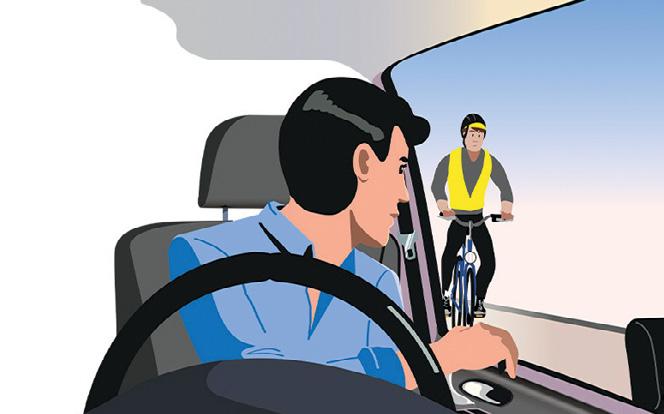
Chain
Clean, tighten and oil your chain to avoid stiffness or slack.
Clean it and check for any dents or cracks.
Use the 2V1 rule. The helmet should rest on the forehead two fingers’ width above the eyebrows. Straps should sit flat, form a V under each ear and fit snugly with room to slide one finger between your chin and chin strap.
Highway Traffic Act requires bikes to have a white light mounted to the front, and a rear red, amber or reflective light. White reflective tape on the front forks and red reflective tape on the rear forks are also recommended.
A simple safety practice, the Dutch Reach cues everyone in a car—driver and passengers alike—how to exit the vehicle and avoid opening the car door in the path of an oncoming cyclist. It’s as easy as…
ONE, reach for the door handle using the hand farthest from the door.
TWO, this will prompt you to swivel and look over your shoulder to check for oncoming traffic.
THREE , once the way is clear, open the door and exit the car safely.
Visit caamanitoba.com/cycling for more cycling safety tips.
You’re going places. Arrive in style
Member price: $54.99
Non-member price: $59.99
Sleek, stylish and geared for work and travel, the Addison is made of sturdy nylon on the lower half and 100% vegan leather on the upper half. A slash-resistant mesh barrier on all four sides, bottom body panels and locking compartments protect your valuables.


Member price: $87.99
Non-member price: $99.99
Made with post-consumer recycled polyester (rPET), this crossbody bag has two spacious compartments for accessible organization, offering convenient storage for essential items such as your phone, wallet, portable charger, headphones and eBook reader.
Member price: $59.99
Non-member price: $67.99
I-mini is a great crossbody travel companion. The front flap opens to a spacious phone compartment, and the zippered back compartment has room for 10 cards.


Member price: $69.99
Non-member price: $79.99
Fit your credit cards, sunglasses and phone in a dedicated slot for quick access, and slip your passport into the inner-mesh compartment. A durable hard-shell cover keeps your belongings dry and protects your valuables from theft.

Member price: $134.99
Non-member price: $149.99
Stylish and versatile, this tote features a convertible zippered trolley sleeve for extra storage—your go-to accessory for staying chic and organized while on the move.
Something catch your eye?
Visit your CAA Store, shop.caamanitoba.com or scan this QR code.
Taking your vehicle to task
GET READY TO shake off the effects of winter. A well-maintained vehicle contributes to safety on the road and can potentially lower insurance rates.
Here are some things to check on to ensure your ride is road-ready.

INTERIOR Cold weather and snow mean road salt, sand and dirt can accumulate in your car. Loosen salt buildup by scrubbing the carpet and floor mats with a brush before vacuuming. If salt stains persist, soak the surfaces with a salt-stain remover and use a towel to soak it up.
BATTERY Check your battery for signs of corrosion and wear, including any compromises (such as bulging) in the casing. And, especially if your battery is more than three years old, consider getting it tested to find out if it needs to be replaced. Visit caamanitoba.com/battery to book a battery assessment.
BRAKES Keeping ahead of brake issues can save you money in the long run. Let your mechanic know if you’ve noticed any change in how your brakes feel, if they’re squealing, grinding or rattling or if there’s a difference in actual braking performance.
FLUIDS Follow the vehicle’s maintenance schedule for fluids, topping up, replacing or flushing. This includes brake, transmission and power-steering fluids, as well as engine oil and coolant.
When you take your vehicle for the 139-point vehicle inspection at a CAA Approved Auto Repair Services™ (AARS) facility, you’ll get a comprehensive report and ranking of maintenance issues, so you can prioritize anything that needs immediate attention.
Visit caamanitoba.com/auto to learn more about quality automotive service.

WINTER IS IN THE REARVIEW MIRROR, but that doesn’t mean driving shouldn’t require your full attention. According to CAA community relations consultant Michael Stewart, you can expect any type of weather. “It’s important to focus on the road, making sure you’re giving yourself plenty of time and following the posted speed limits.” Here are some more of Stewart’s tips for staying safe as the weather shifts.
• Check the weather forecast along your route—you might be driving into an area with icy roads and reduced visibility. And, as always, be aware and have a plan.
• There are, of course, best practices that apply to driving, no matter what the season. Eliminate distractions, so you can concentrate on driving. That includes mapping your route and setting up playlists before you leave.
• Ensure your headlights are on when you’re driving at night or in low-visibility situations. Observe posted speed limits and signs warning of animals crossing, sudden S-curves and other potential hazards. Watch for vulnerable road users, such as cyclists, pedestrians and road workers.
Stewart notes that the safest driver is one who’s not in a hurry—another tip that applies year-round—but spring’s a great time to make taking it easy a part of your daily driving routine.
Visit caamanitoba.com/advocacy for tips and information on road safety.
CAA Mobile Tire Change is the way forward

Everyone wants to get on the road this time of year. And installing seasonal tires is a moment many of us have been waiting for. Why wait any longer? CAA Members who opt for the convenience of CAA Mobile Tire Change service get their on-rim tires swapped out right in their own driveway.
The rates are competitive, too. Households with two vehicles save $20 on the second tire change.
As an extra service, the CAA Technician can provide a complimentary battery test, which is always a good idea—that way, you can stay in charge of your car’s battery performance. CAA Mobile Tire Change is available in Winnipeg and Brandon from April 15 to June 15, 2024, and can be booked online.
Visit caamanitoba.com/mobiletirechange to book, starting April 1.





From epic multi-country adventures to quiet, sun-soaked getaways, CAA’s trusted partners can take you there. With insider tips, immersive experiences and exclusive perks for CAA Members, we’ll show you Europe like never before.
To start planning your European getaway, visit caamanitoba.com/Europe2024 or call 1-888-888-1475.

You may know me from my history in Canadian media as the Founder of CityTV, MuchMusic, Bravo!, Space and some 20 other channels or, more recently, as the Founder of ZoomerMedia. But you may not know that I’m also the Chairman of CARP, the Canadian Association of Retired Persons, which—like CAA—is a trusted national not-forprofit organization whose origin is anchored in advocacy.
CARP’s mandate is not only to advocate for Canadians As We Age but, like CAA, to also provide many exclusive benefits to our members. That’s why earlier this year, Jay Woo, your CEO, and I were pleased to announce that CAA had become our new exclusive CARP Recommended partner to offer the right insurance for older Canadians at the best prices. In another essential product category, we have also just announced Rogers Powered by Zoomer—more affordable wireless devices and low-cost plans to help CARP members stay connected by phone and email. Why should you pay more for services and data you don’t need? We invite you to visit carp.ca to learn how you too can benefit from the same low rate and generous data plan and get access to amazing everyday 20% off all Rexall home brand drugstore essentials, plus dozens of other benefits.
Like CAA, CARP advocates for its members and has racked up significant public policy wins like the abolition of Mandatory Retirement, an increase in the Guaranteed Income Supplement (GIS) for low-income seniors and income splitting for couples for tax purposes.
So, my friend Jay, who thinks CARP is a good thing and is a member himself, has generously given me this space to offer all CAA members “A Deal To Remember.” Here’s how I put it: “5 bucks 5 bucks, 10 bucks 10 bucks or The Whole Thing for 20.”


For the first year, CAA members can join CARP for only $5 and get a one-year subscription to Zoomer Magazine for just another $5. In the second year, you pay only $10 each for the membership and magazine. Or, better yet, get two years of CARP and two years of Zoomer—a regular $60 value—for only $20. It is the best deal ever because I really, really want to make it easy and fun for you to join. To find out more, please visit carp.ca/CAA offer or call 1-833-211-2277
A glimpse into how positive change becomes a reality
ADVOCATING FOR MEMBER SAFETY is one of CAA’s prime drivers. Teresa Di Felice, assistant vice president of government and community relations, offers some insight into how CAA works with its Membership, the government and other stakeholders to effect positive change.
How does advocacy fit into the mission of CAA?
Most people aren’t aware that advocacy is how CAA started in 1913. It actually began with a few car enthusiasts, back when cars weren’t as prevalent on our roads. But there was a recognition that this was the technology of the future and that cars actually served the potential for some great purposes, like connecting communities. So, advocacy back then was about how to coexist on the roads with other forms of transportation—like bicycles, horses, trolleys, transit vehicles. Today, it’s still about moving people safely.
So how did that play out in the early years and how does it look today?
Among the first CAA advocacy services were the installing of road signs, launching the CAA School Safety Patrol® (SSP) program and advocating for the building of the Trans-Canada Highway. CAA is a membership organization, so the community aspect was very big. One of our most recognized community efforts is the SSP program. There’s a sense of ownership, not just at CAA, but also among the partners who deliver the program. And for the kids on the ground who are actually involved, the program is a source of pride. I can’t tell you how many police officers have told us they used to be School Safety Patrollers.
How does CAA decide where to focus advocacy resources?
We focus on two areas—community relations, which we spoke about. The other is education and awareness around road safety issues that are critical to keeping our communities safe. These include distracted driving, impaired driving, speeding, stunt driving and sharing the road with cyclists.
We’re also tracking current issues—such as electric vehicles and cannabis-impaired driving—to inform ourselves and our Members. And that speaks to the government relations side—working with government to create awareness and share what’s on the minds of CAA Members. We survey our Members quite a lot throughout the year. This can help inform public policy. We are deeply entrenched in the evolution of these issues to work towards solutions that help mitigate and resolve safety issues on our roads.

INTRODUCING
IN YOUR CORNER a regular feature on how CAA is making a difference in your communities
WHEN THE SNOW MELTS AND THE POTHOLES EMERGE it’s time for drivers to nominate the worst Manitoba roads they’ve encountered.
Established in Manitoba in 2012, the CAA Worst Roads campaign has become an annual focal point for CAA’s advocacy efforts. But it’s not about just venting over crumbling infrastructure and expensive vehicle repairs. Steadily increasing traffic and mobility issues—for drivers, transit users, cyclists and pedestrians—mean everyone is affected by the routes designed to manage the movement of people. This includes bike lanes, traffic circles, lighting and signaling, red-light cameras, speed bumps and more.
When drivers have their say, the results are tangible, says Teresa Di Felice, CAA Club Group’s assistant vice president for government and community relations.
“No government, no municipality wants to be on the top 10 list. I’ve had politicians come up to me and say, ‘Yeah, I don’t like the name of your campaign, but you actually highlighted something. We didn’t realize how big an issue this was.’ ”
Some politicians, Di Felice notes, then allocate resources to get work done faster. For example, as a city councillor, (now mayor) Scott Gillingham used the list to prioritize which roads in his ward got fixed.
So the Worst Roads campaign continues to influence change. Repair work has been done on many of the roads on Manitoba’s list—with more to come.
Visit caamanitoba.com/worstroads to learn more about the advocacy work being done. And, from March 19 to April 12, vote daily for your worst road.
CAA survey shared insights and concerns ahead of election
IN THE LEAD-UP to last October’s provincial election, CAA Manitoba’s Government and Community Relations (GCR) team surveyed Members on the issues that mattered most to them. The survey asked questions on road safety issues, voting habits, and their hopes for the future.

“It was a dramatic election,” said Ewald Friesen, manager of government and community relations for CAA Manitoba.
“The sitting Progressive Conservative government lost to the New Democratic Party headed by now Premier Wab Kinew, who became Canada’s first First Nations Premier.”
Here are some highlights of the survey:
More than 90 percent of CAA Members voted in the past and intended to vote in this most recent election.
Members are civically engaged, with four in 10 taking an action in the previous two years—popular actions included signing an online petition or writing to government officials.
Visit caamanitoba.com/advocacy to learn more about the work of CAA Manitoba’s GCR team.

In a list of road-related issues presented to Members, the top concerns were violence on Winnipeg Transit, deterioration (potholes) of urban streets and poor highway repair. Ninety percent of Members cited the following as priorities—cost of living/inflation, road infrastructure, road safety and impaired driving.

August 16–31, 2024 & August 30−September 14, 2024 | 16 Days

The best way to explore the world’s natural wonders? Up close and personal, by rail and sea, like on this 16-day journey. Start on land in Alberta, with stops in Banff—home of Canada’s historic rst national park— to see the stunning blue-green waters of Lake Louise and on to Jasper’s Dark Sky Preserve for unforgettable stargazing. Then, board Rocky Mountaineer® for the three-day Rainforest to Gold Rush train journey through the scenic Canadian Rockies, stopping in charming Quesnel, idyllic Whistler and bustling Vancouver. From there, board the Koningsdam for a seven-night Alaskan cruise that will take you through the glacier-dotted Inside Passage, to Juneau, Skagway and Ketchikan. You won’t want to miss a thing.
• $25 CAD Beverage card†
• $250 USD Shipboard Credit‡
• 50 CAA Dollars®^
• 25% savings on CAA Travel Insurance◊
• Airfare from Toronto or Winnipeg to Calgary, and return from Vancouver to Toronto or Winnipeg
• Pre-cruise tour:
- 2-night stay in rst-class accommodation in Banff
- 2-night stay in moderate-class accommodation in Jasper
- 1-night stay in moderate-class accommodation in Quesnel
- 1-night stay in rst-class accommodation in Whistler
- 2-night stay in rst-class accommodation in Vancouver
- 3 days onboard Rocky Mountaineer from Jasper to Vancouver in GoldLeaf Service®
- 7 breakfasts, 3 lunches, 3 dinners and 1 snack
- Sightseeing and entrance fees as per itinerary
- Local English-speaking guide
- Hotel portage of 1 suitcase per person
- Prepaid gratuities on Rocky Mountaineer
• 7-night Alaska cruise on-board the Koningsdam
• Onboard meals and entertainment as per cruise itinerary
• Have It All Package:
- Premium Wi-Fi
- Elite beverage package
- Shore excursion discount
$13,669–$14,279
- 1-night specialty dining
- Prepaid gratuities
• Destination transfers



October 25–November 5, 2024
12 Days
Immerse yourself in Spain’s storied history and culture on this unforgettable 12-day itinerary. Start in Madrid where you’ll explore iconic landmarks like the Royal Palace and take in a traditional Flamenco dinner show. Continue to Cordoba to visit the UNESCO-listed town of Toledo. Discover the enchanting city of Seville, with its grand Cathedral, Royal Alcazar, and vibrant Santa Cruz quarter. Experience the captivating fusion of Islamic, Spanish and Renaissance architecture in Granada. Wander the picturesque port city of Valencia, and conclude your tour with paella in Barcelona. Admire Gaudi’s architectural masterpieces including the awe-inspiring Sagrada Familia. Depart with cherished memories of Spain’s rich heritage and culinary delights.

September 30–October 22, 2024
23 Days
Embark on an unforgettable Maltese adventure with a 23-day extended tour of this captivating island nation. Your journey through Malta’s rich cultural mosaic begins in Gzira at the exquisite Grands Suites Hotel Residences & Spa. Follow expert guides as they unveil Valetta’s history through tours of St. John’s Co-Cathedral and Casa Rocca Piccola, then enjoy a picturesque Dghajsa water taxi to Birgu. Immerse yourself in the history of Rabat’s St. Paul’s Catacombs, bask in the splendor of Mdina Cathedral, and marvel at the medieval Palazzo Falson. Throughout your journey, savour local folklore and cuisine for an authentic experience like no other. Explore this dynamic Mediterranean country and its fusion of culture, cuisine and coastal beauty at a pace that lets you soak it all in.


October 1–14, 2024 | 14 Days
Morocco is famous for the mystique of its colourful markets, the drama of the Sahara Desert landscape and Casablanca, of course. This 14-day trip lets you experience the most authentic—and beautiful—version of this enchanting North African country. You’ll start in Casablanca and take in the stunning architecture of the nation’s largest mosque and bustling open-air markets, before moving onto the UNESCO-protected ancient Roman ruins of Volubilis. Next is Fes, where you’ll tour the Royal Palace and enjoy a private cooking class. Then, head out to the desert and camp out at the magical Merzouga Luxury Camp for stargazing, before driving through the Dadès Gorges. Don’t forget glamorous Marrakech, where you’ll tour historic monuments, the renowned Yves Saint Laurent Museum and learn how to make your own Moroccan slippers.
All booking deposits are fully refundable up to the time of the nal payment.††
redeem CAA Dollars, you must be a current CAA Member over 18 years old in good standing. CAA Dollars will be credited at time of departure. Visit caamanitoba.com/caadollars for more information. ◊CAA Travel Insurance is underwritten by Orion Travel Insurance Company, a CAA Company. Applies to CAA Manitoba Members in good standing. 25% savings is made up of a 10% Member savings as well as a promotional 15% savings when you purchase an Extraordinary Explorations tour through CAA Travel. Offer valid until December 31, 2024. Savings apply to the total premium excluding applicable taxes. Minimum premium applies. Visitors to Canada Insurance savings limited to the promotional savings. Certain exclusions, limitations and restrictions apply. Subject to change without notice. A Medical Questionnaire may be required to purchase travel insurance. ††Decision to book a non-refundable air fare or







Winter may have left its mark on your home since you last checked. A little repair work now can save you a lot down the road.
Test the seals on windows and doors If windows rattle or you can feel air through them or see daylight around door or window frames, there are gaps. Seal them with caulking or weatherstripping.
Look over ceilings and walls
Mildew spots, large brown or yellow stains or bubbling paint are signs of water damage. Bring in a plumber or restoration specialist.
Test sump pumps, sensors and backflow valves Confirm that they’re functioning and ready for a wet spring.
Clean furnace and air conditioning units Call an HVAC specialist to ensure these are working efficiently to help reduce dust and your heating and cooling costs.
Test smoke detectors and carbon monoxide detectors
Refresh batteries and replace any expired detectors.
10 essential tasks to help protect your home— and possibly prevent insurance claims
Check the roof Look for buckling that could indicate structural damage. Replace any damaged shingles—look for rust on metal shingles and cracks in clay, slate or wood shingles (which can also rot).
Clean the eavestroughs Ensure that eavestroughs and downspouts are clear of debris and are connected and positioned to direct water away from the house.
Repair driveways and walkways
Replace broken paving stones and repair hairline cracks in your driveway with a masonry filler. Wider jagged gaps may need to be repaired by repouring concrete.
Touch up woodwork Repair loose planks and check for rot on your deck, porch, stairs, railings and fences.
Inspect the foundation Hairline cracks can usually be fixed with a DIY crack-injection kit. Bigger cracks or large gaps between bricks may require a professional to repair them. Check to see if driveways, sidewalks, decks and patios have the appropriate grading to direct water away from your home.
Spring is also the time to review your insurance policy. Does your policy include coverage for water damage from flooding, heavy rainfall or sewer backup? Visit caamanitoba.com/SpringRepairs to learn more.

Winnipeg student Marissa Magsino puts mealworms to work
By Andrew McKayYOU’RE NEVER TOO YOUNG to be a good neighbour.
Marissa Magsino’s journey to public service and environmental stewardship started in Grade 6, with a science fair. Earning a gold medal at the Bison Regional Science Fair and a silver medal at the Manitoba Schools Science Symposium put her on a track towards scientific discovery that continues to this day.
Winnipeg student Marissa Magsino’s achievements in research have garnered awards and motivated her outside the lab as well.

“Winning at a provincial level inspired me more to keep going,” says Magsino, who’s in Grade 12 at St. Mary’s Academy, in Winnipeg.
“I’m a very competitive person, so I use competitiveness in the right direction. When you’re young, you’re curious about a lot of different things, like the intrigue of exploring new and fairly undiscovered research.”
Magsino’s research led her to an unconventional subject: mealworms. Her Grade 10 science fair project focused on using toxins to modify the behaviour of mealworms “to maximize the biodegradation of polystyrene.” In other words, she taught mealworms how to break down Styrofoam.
The project won the intermediate gold at 2022 Manitoba Schools Science Symposium, as a well as awards from the Canadian Institute of Food Science & Technology, Engineer and Geoscientists of Manitoba, and the Sanofi International BioGENEius Challenge Award.
In many ways, Magsino is a typical student with plenty of extra-curriculars. She runs on the school track team and has a side hustle selling soap products. She even has a summer job, as a cashier for the Winnipeg Goldeyes baseball team, a CAA Manitoba partner.
“Some friends who worked there previously said it was a good first job to learn a lot of easy skills,” Magsino says. “It’s honestly been one of my favourite jobs because it’s such a fun environment. People are happy to get out and enjoy something in their community. I’m happy to be a part of that.”
I’m a very competitive person, so I use competitiveness in the right direction
She put her research into action, implementing a mealworm recycling station in her school, where students could put their Styrofoam and the mealworms would biodegrade it on-site.
“Motivation sparks your initial inspiration on what you’re doing,” she says. “But then, discipline and passion keep you going and help you to continue to do work for the goodness of others.”
Magsino’s drive to help has grown into other areas. She was elected to the Youth Advisory Climate Council for the Manitoba government and has been doing work with them for almost two years.
“Science really motivated me in other parts of my life to get involved in so many things,” she says. “I was surrounded by peers who were also inspired to get involved in everything around them, and it made me curious how to change the world.”
In 2022, Magsino’s commitment to service was recognized by the Nellie McClung Foundation as one of 10 winners of the “Yes I Can” Leadership Award for women aged 16 to 25.
Even there, Magsino finds ways to be a good neighbour.
“She was an exceptional employee: very friendly, outgoing, professional, trustworthy, with attention to detail, proactive and reliable,” says Melissa Schlichting, food and beverage manager for the Goldeyes and Magsino’s boss.
“She was the first one to pick up extra shifts when we were short-staffed and take new staff under her wing to show them the ropes. I hope to have her return next season!”
As she gets ready to graduate from St. Mary’s, Magsino has her sights set firmly on the future. She plans to attend the University of Manitoba to continue her research in biochemistry, and then medical school. She hopes that, one day, she can reward the people and groups that put her on a path to success.
“I want to be able to give back to the science fair,” Magsino says. “I’d like to run the Manitoba School Science Symposium one day. That was the starting point and it opened a lot of doors for me, so I want to give other youth the opportunity to get involved.”
Scan the QR code for more great stories about inspiring people.





Whether you’re taking a dip in the pool or diving off the dock, find swimsuits you’re excited to wear from Swimwear Express.
• Find everything you need from bikinis, tankinis and one-pieces.
• A wide variety of high- and low-waisted bottoms, including swim shorts and skirts.
• A great selection for all shapes and sizes ranging from 4 to 24.
• CAA Members receive 10% off their purchase (discount up to a value of $30).



Built in the 1900s, this dam was a home for hydroelectricity for 45 years. Out of commission since the ’50s and now part of a provincial park, this semi-demolished relic has stood the test of time and now lets the water flow freely.

Think you know where this is? Send us a note to magazine@caamanitoba.ca with the subject line “Where in the World?” and tell us about it. And check out our Summer 2024 issue for the location reveal!



























































 Diana Coatsworth
Diana Coatsworth

Your passion for Canada’s natural spaces defines your life; now it can define your legacy. With a gift in your Will to the Nature Conservancy of Canada, no matter the size, you can help protect our most vulnerable habitats and the wildlife that live there. For today, for tomorrow and for generations to come.
Order your Free Legacy Information Booklet today! Call Jackie at 1-877-231-3552 x2275 or visit DefineYourLegacy.ca